The blossom on the first seedling to produce flowers has opened. Some sixty-ish seedlings are NOT flowering, and vary between Nothing and Lots Of Leaves. But this Gala pippin is giving it a good go. Here’s a photo from a couple of days ago.
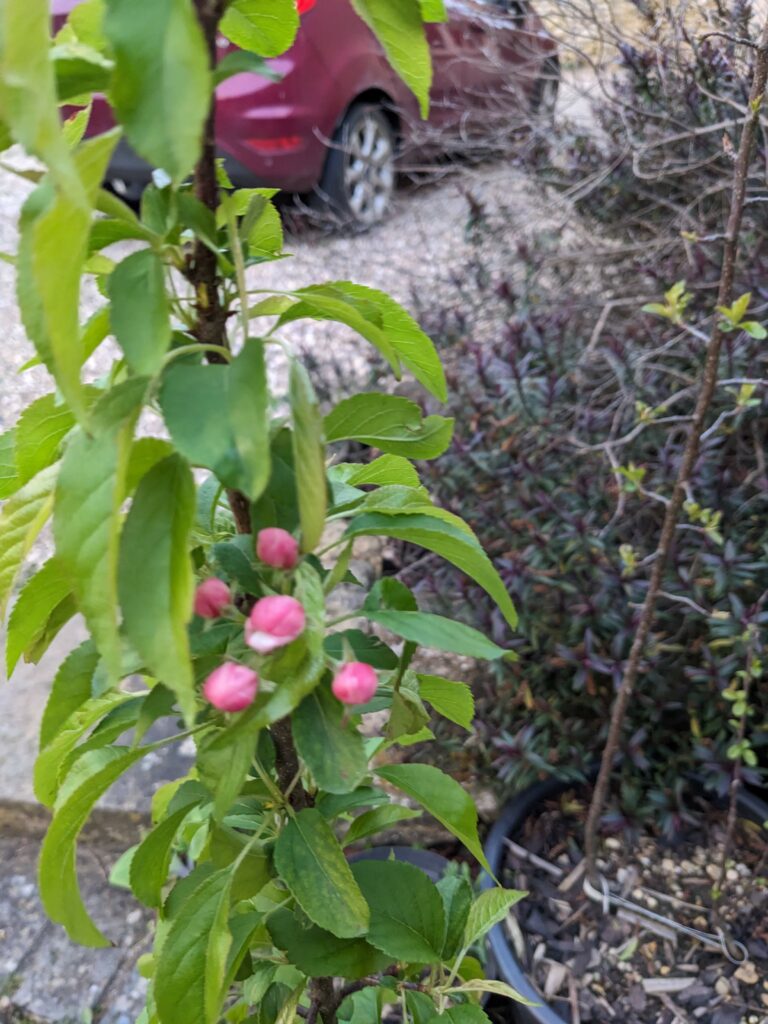
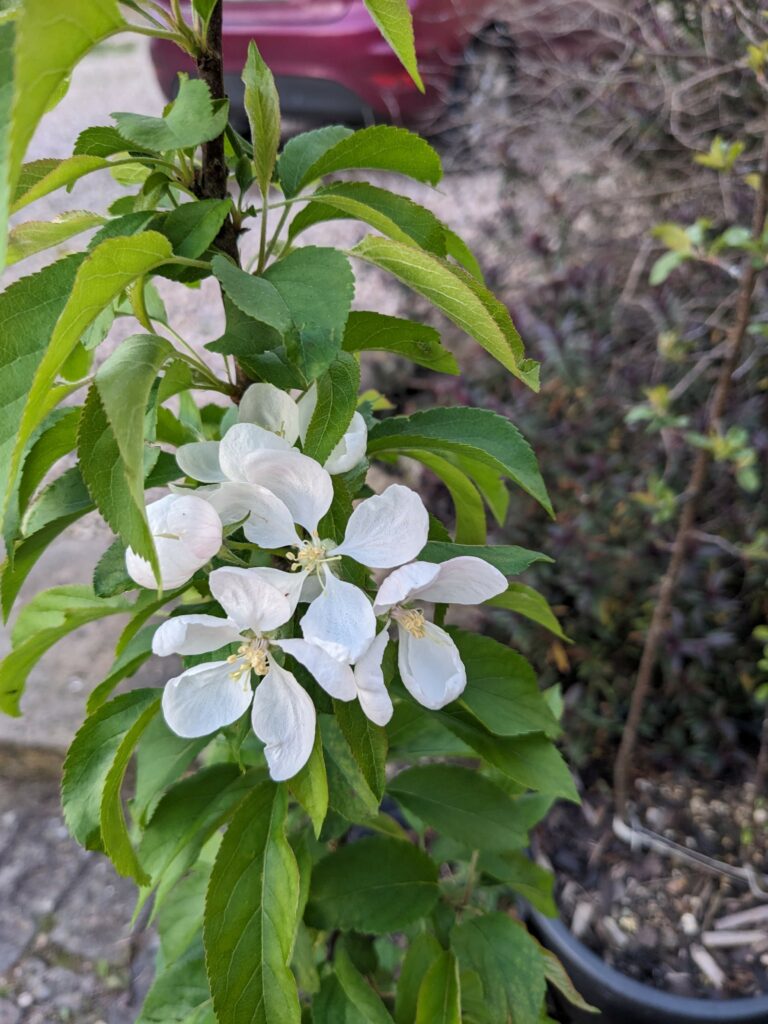
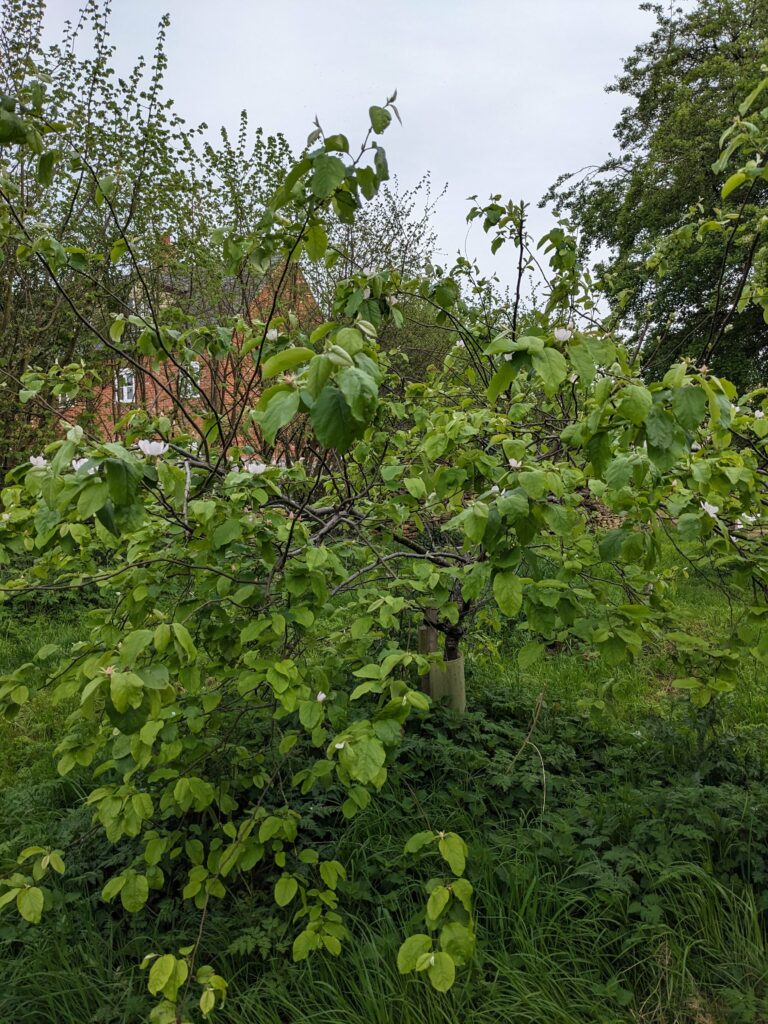
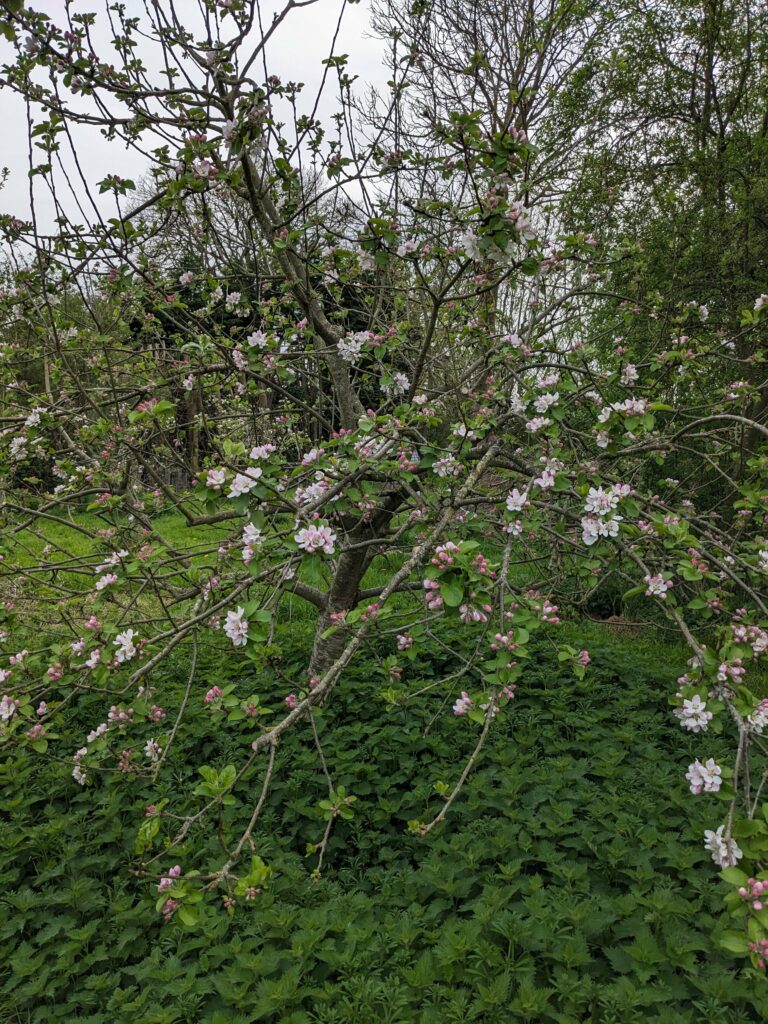
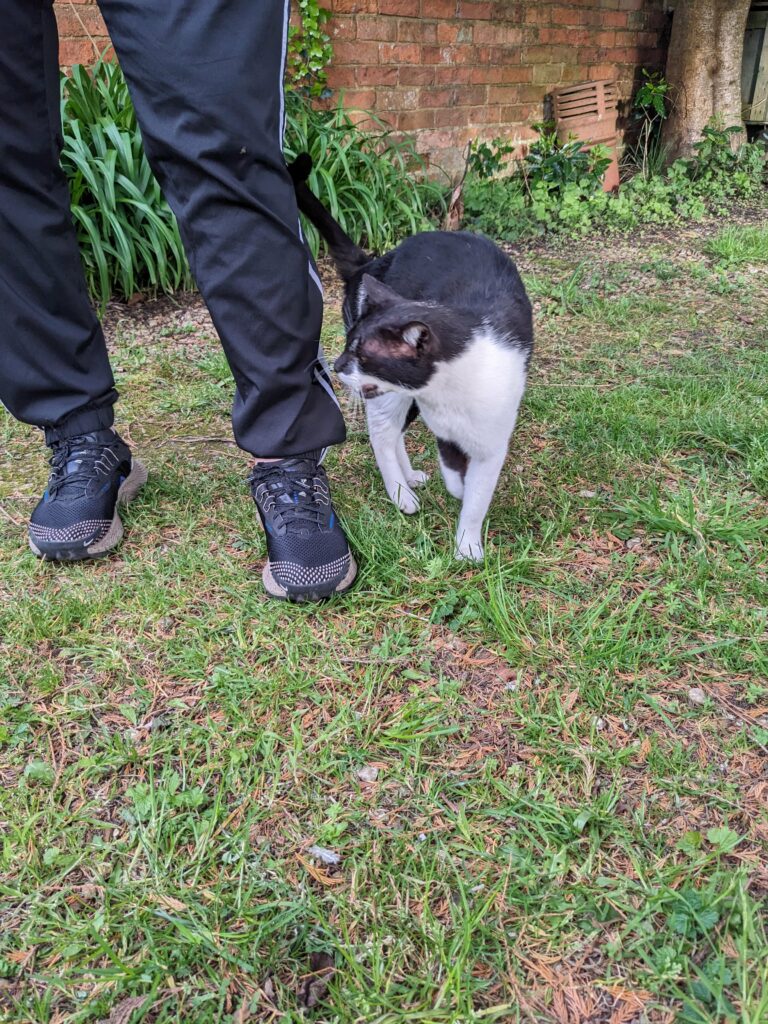
The blossom on the first seedling to produce flowers has opened. Some sixty-ish seedlings are NOT flowering, and vary between Nothing and Lots Of Leaves. But this Gala pippin is giving it a good go. Here’s a photo from a couple of days ago.





The apple store is empty! It’s the end of March, just before Easter so we’re in the tail end of Lent (from the Old English ‘lencten’ meaning ‘when the days lengthen’ i.e. spring), and I took the last two apples out of the store in the gatehouse. This is the time of year known as the Hungry Gap (which may explain why Lent is in this season – make a virtue of a necessity), as the stored food runs low and there’s not much in season yet. Well, there are plenty of nettles, and I imagine the early medieval people would have cooked and eaten them along with other spring greens. Protein from eggs? But not so much bulk food, unless you had a good harvest and good fortune storing it.
Quite a lot of the apples weren’t eatable, as the flesh turned brown, or bruises spread across the entire fruit. But the bottom couple of drawers seem to have fared better, with the apple flesh still white and crisp. Maybe it was that bit cooler?
The bulk of last year’s apples were Bramleys, which ripen up into a very pleasant eating apple in defiance of the supermarket practice of only selling them green (and huge!). My Bramleys varied between VAST MONSTERS and cute little things.
This year I hope we’ll get more of the other varieties, just for, well, variety, and also because some of them may be better keepers – and older varieties, closer to what our Anglo-Saxon nuns would have known.
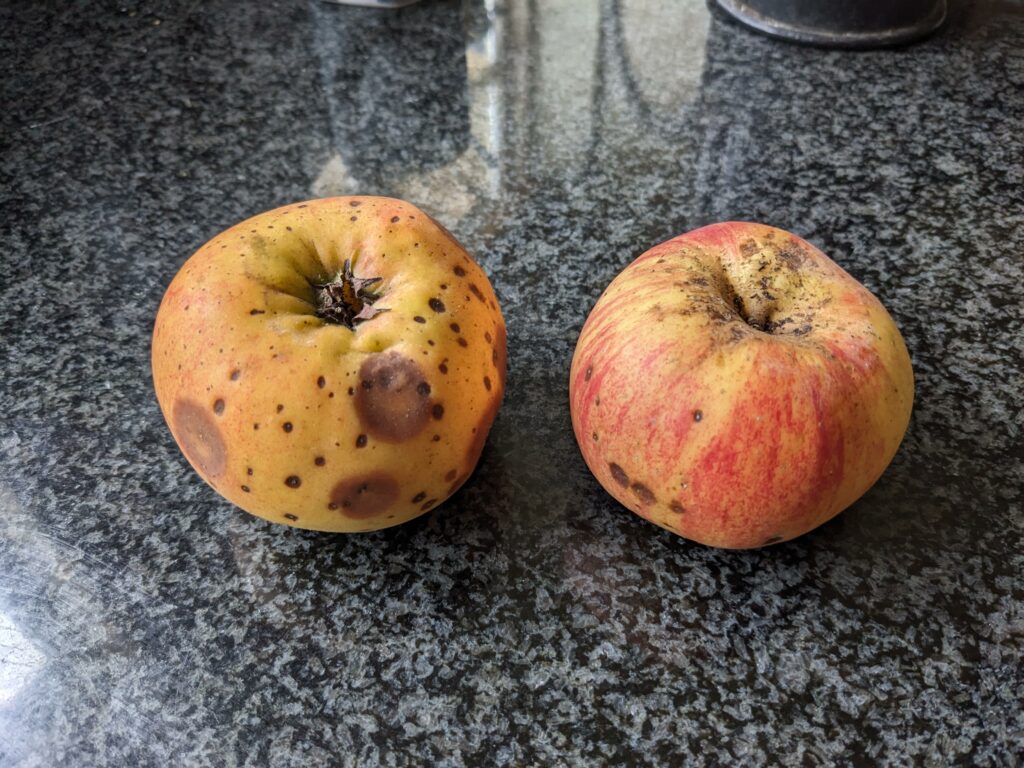
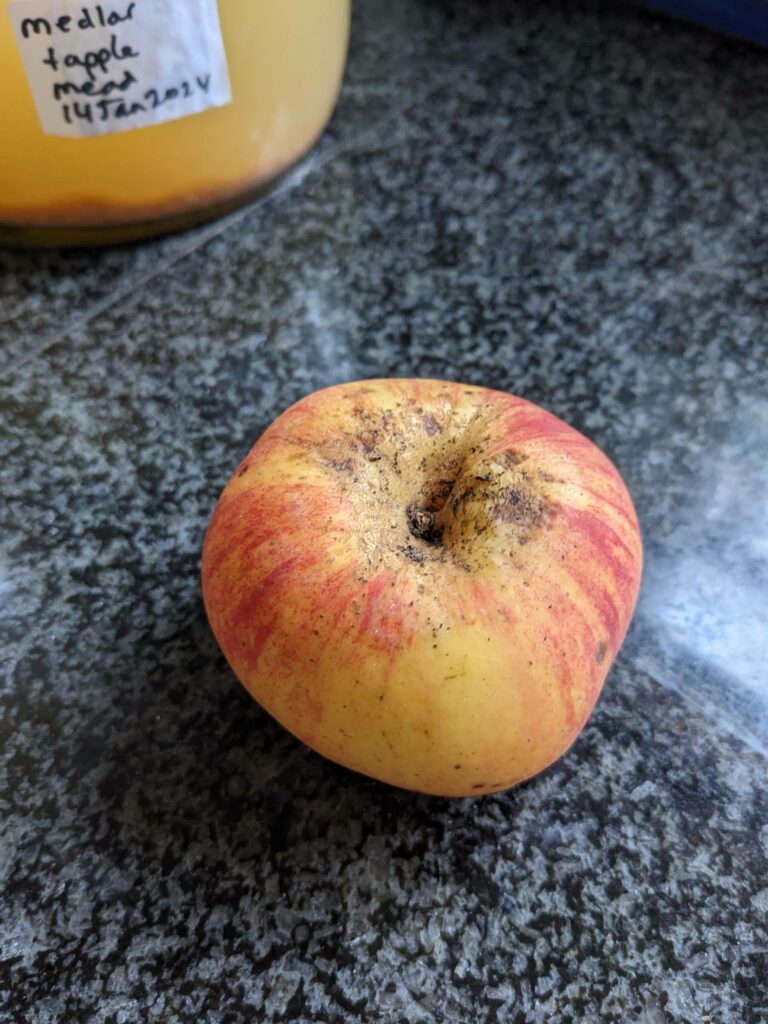
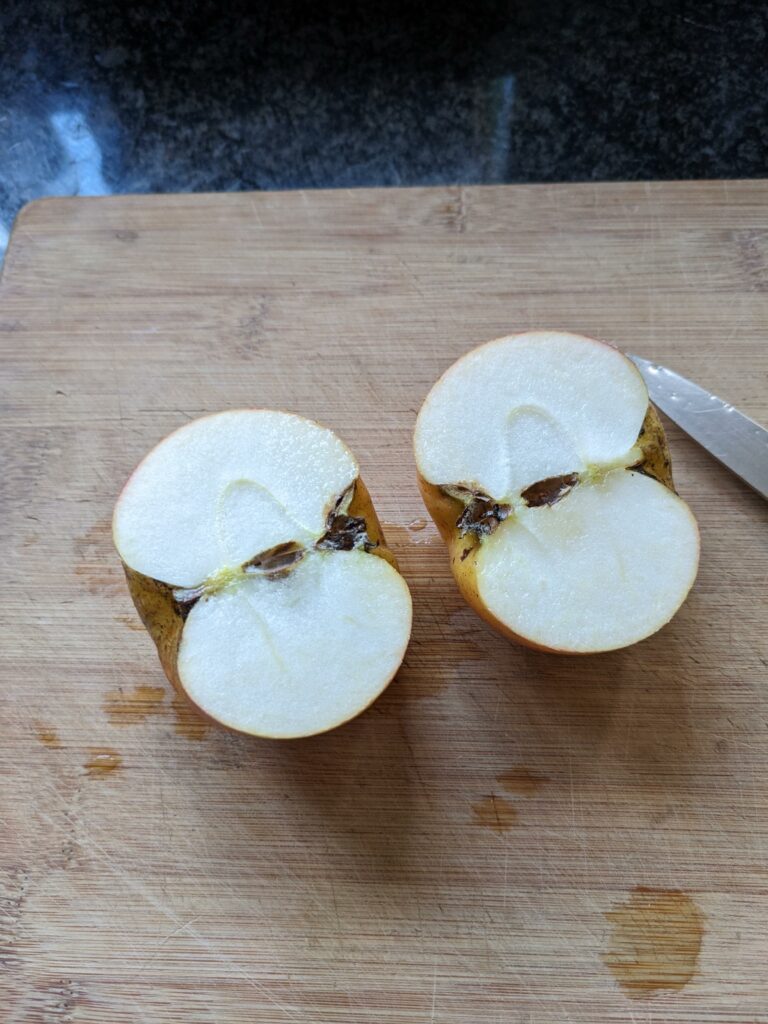
The final apple was a beaut! Very tasty.
The orchard did well; the apples have kept me going at about 1 per day plus crumbles and apple sauce, since 1 August 2023 to 26 March 2024. The trees were affected by a late air frost, or something, and didn’t produce at their maximum, though the Bramley did pretty darn well. Some of my friends reported having no harvest at all last year, so Rumwoldstow was luckier than many.
What we didn’t get was pears; the older two (planted in 2018) flowered and set fruit, but dropped them all. When they were pruned, it transpired that they must have not been planted properly because there was a pot-shaped block of earth with the tree coming out of it, which wobbled alarmingly. Our pruner, Michael, suggested that the trees dropped their fruit because they didn’t feel stable enough to carry them, and also that perhaps because the ground is so wet, they hadn’t felt it necessary to send roots out searching for water. Al and Michael staked them up to be more stable, also the quince was a bit sideways so they staked that too. Fingers crossed this will help them. The two apple trees (Wyken Pippin and Hambledon Deux Ans) look fine; they may have been planted from bare roots? It shows the importance of spreading the roots from a pot-bound tree when planting it out. I’ll have to bear this in mind when the seedlings are being set loose on the world, wherever and whenever that ends up being.
The pear trees are in blossom, as are the plum and damsons. The apples are just starting to bud.
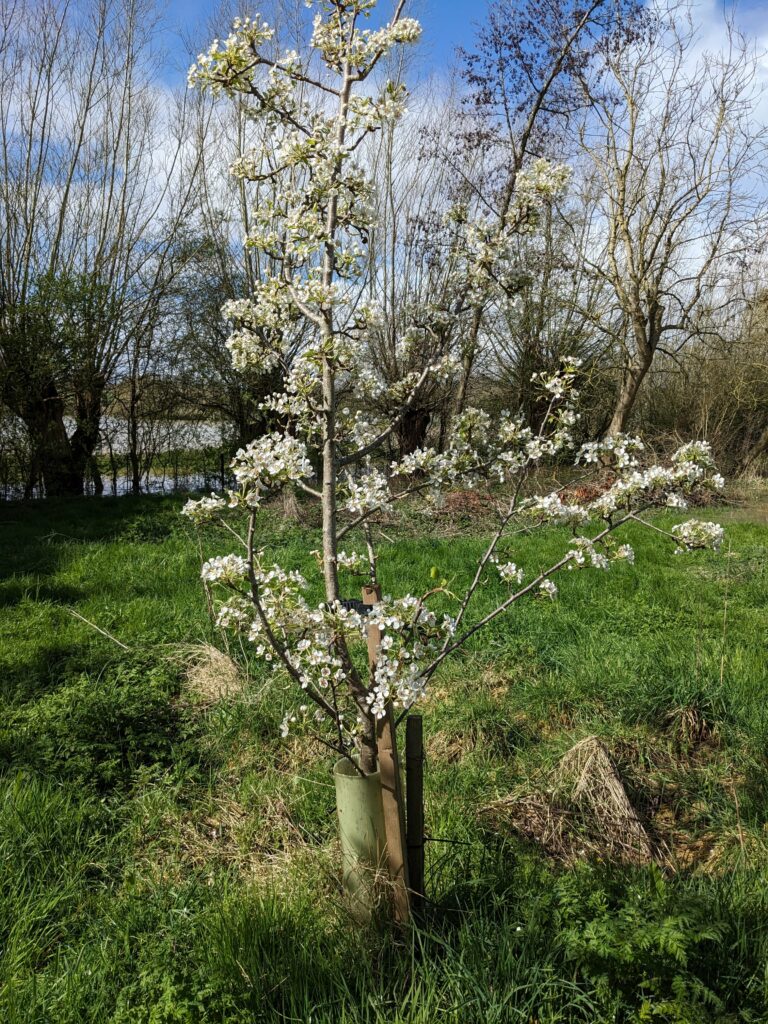
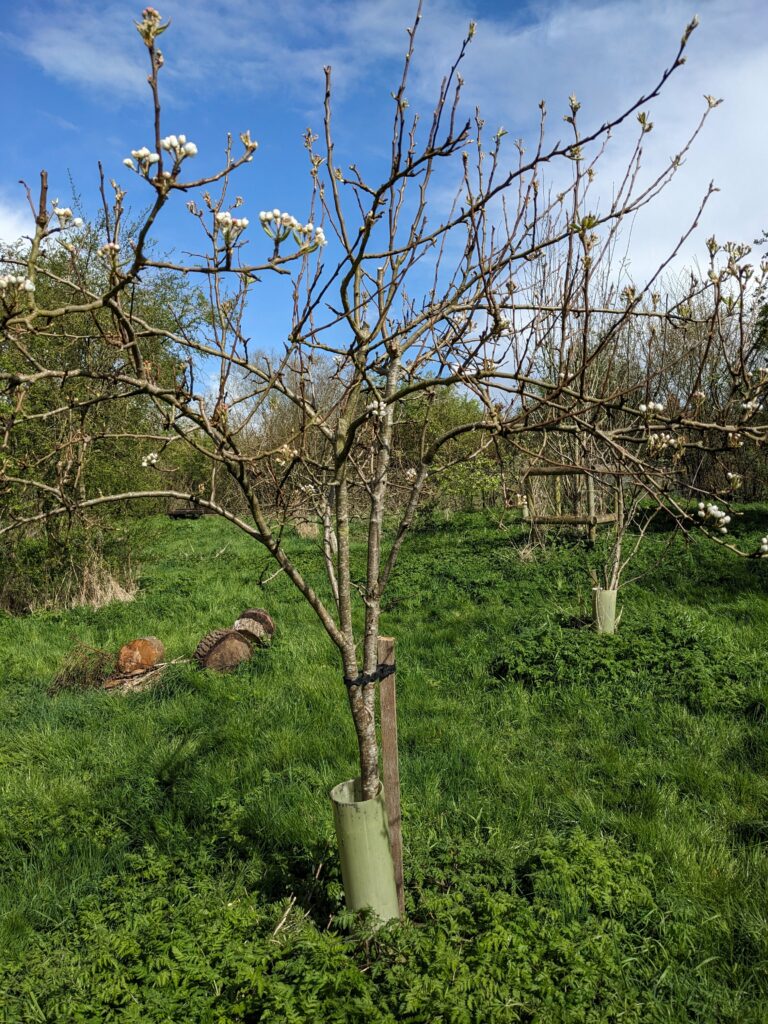
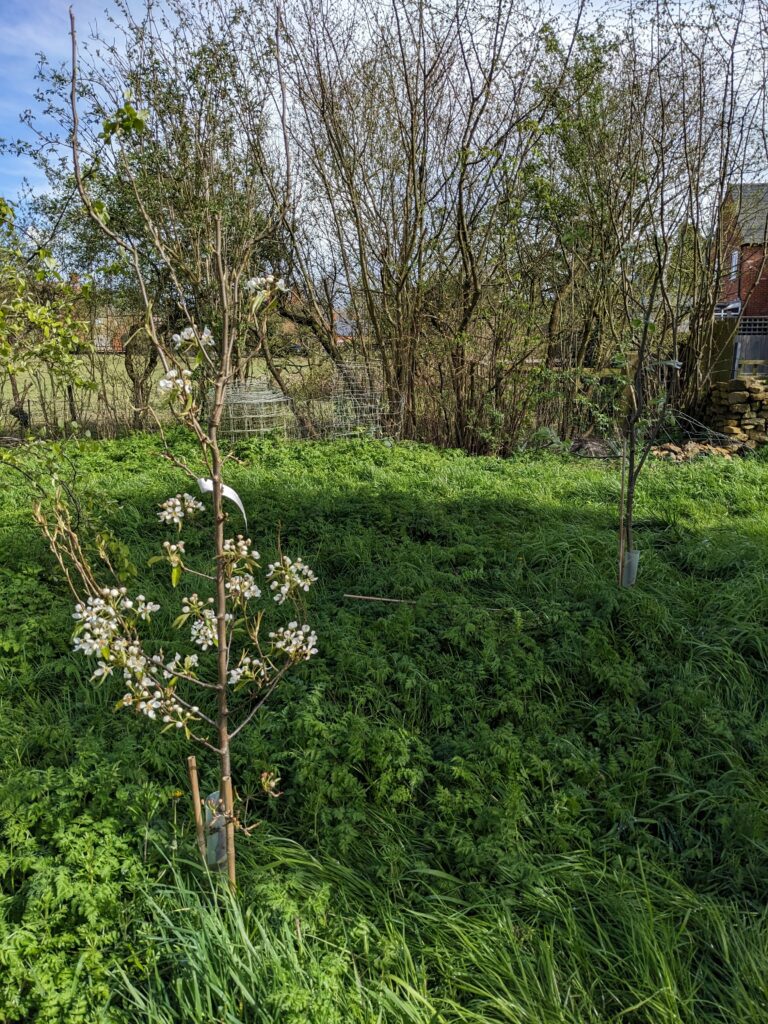
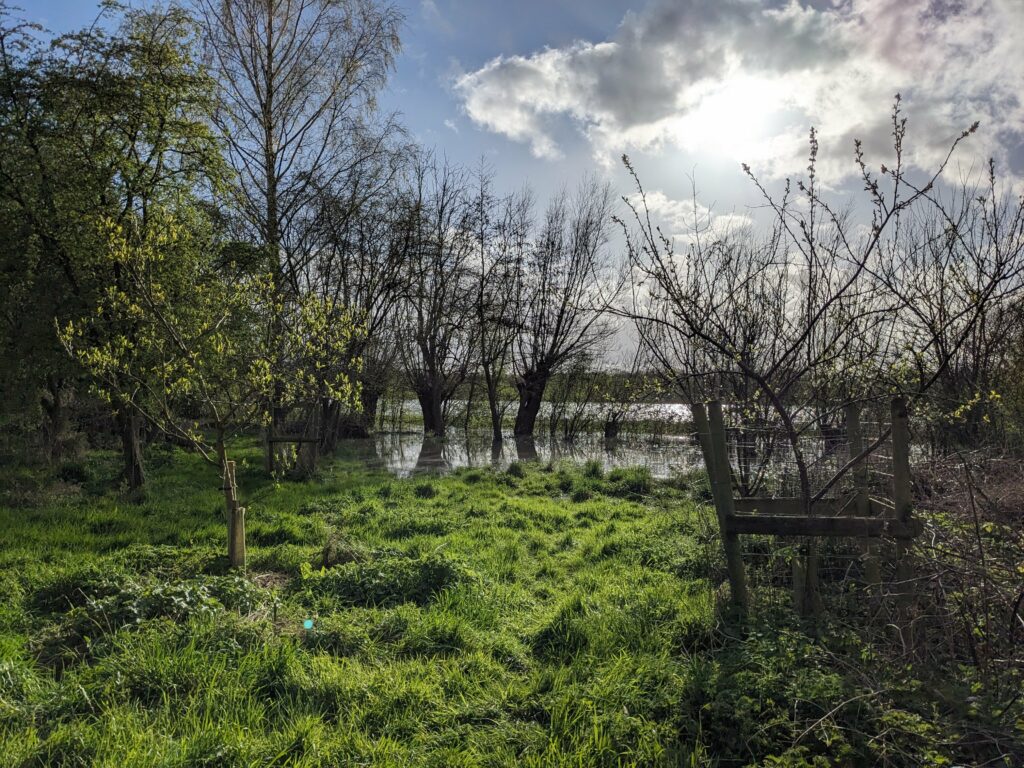
So yeah, a very strong sense of ending and renewal.
Look carefully at the photo…do you see them? Yes, the first ever flower buds from one of my apple tree seedlings! These were grown from apples collected in 2020 and germinated in 2021, so they are now three years old. I need to do an audit and empty out the pots of those that died over the winter but I must still have a good 50 saplings in pots dotted around the patio.
It’s unlikely that these flowers will produce fruit but it’s still very exciting to see one of the little trees take this step forward!
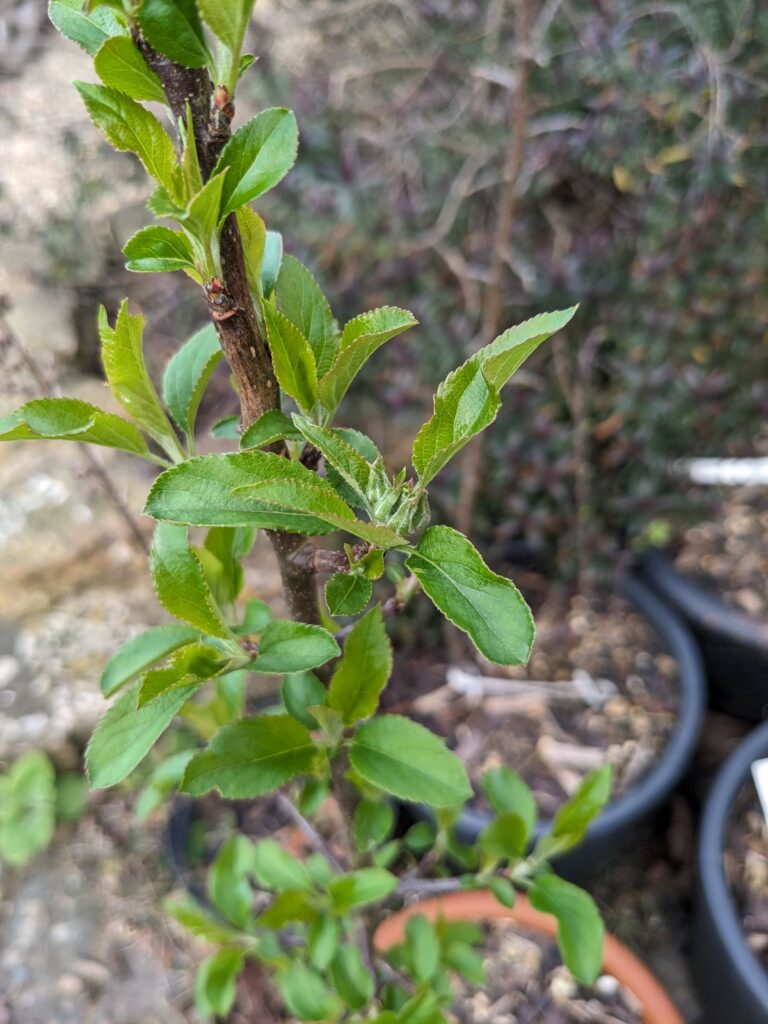
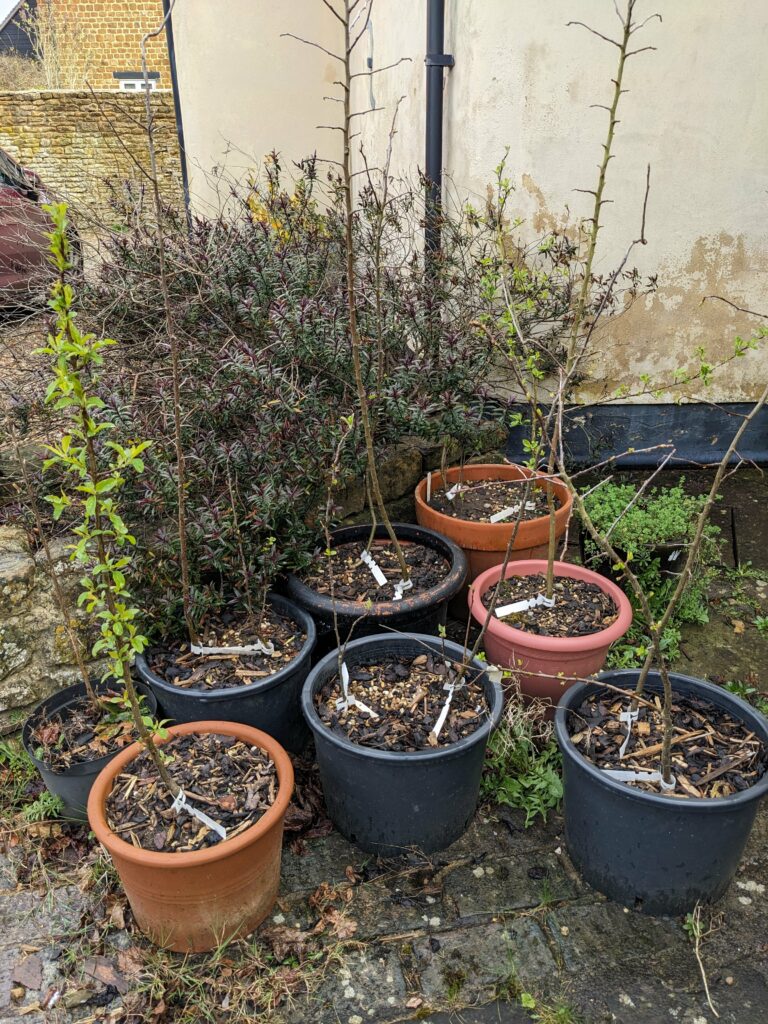
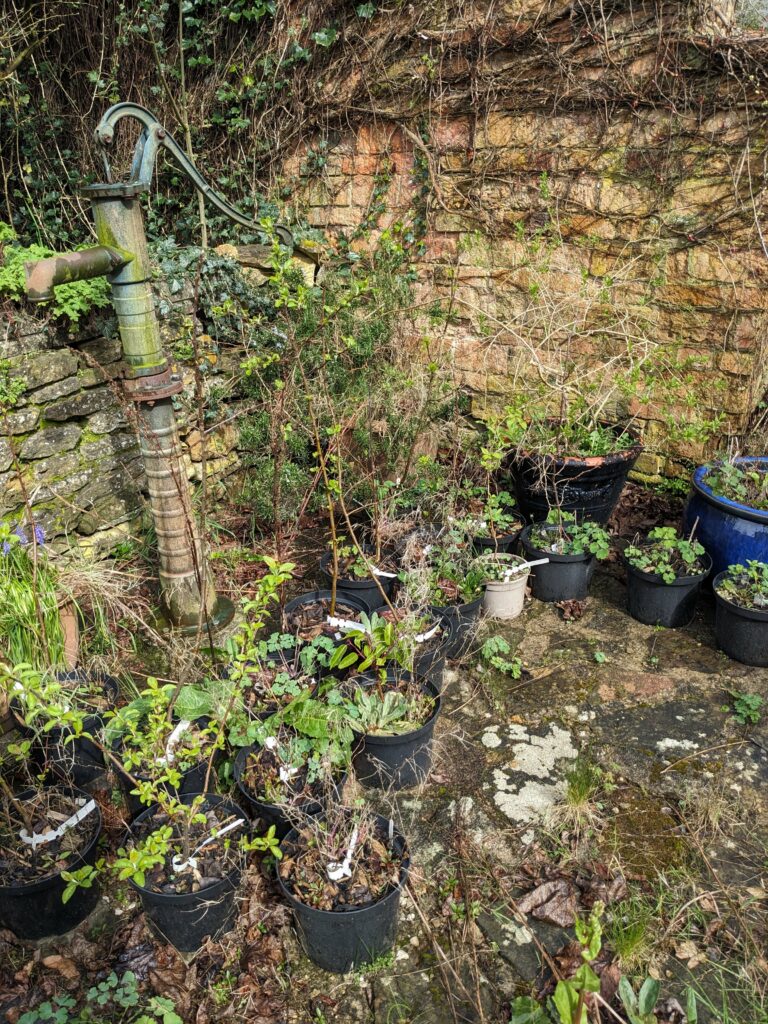
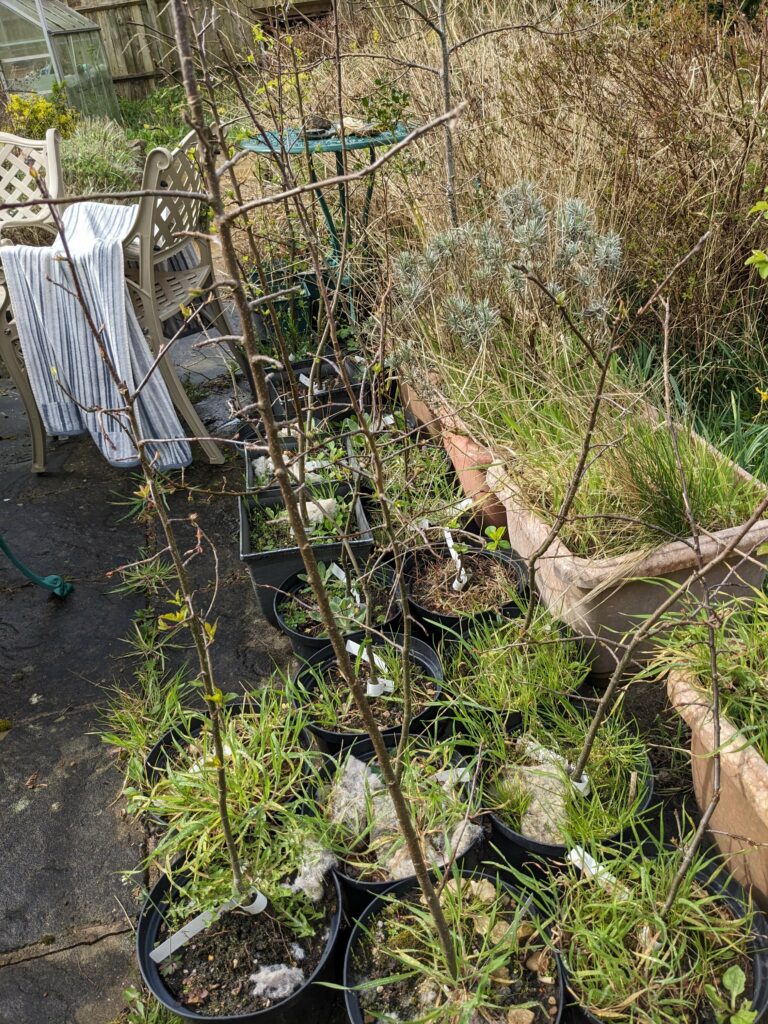
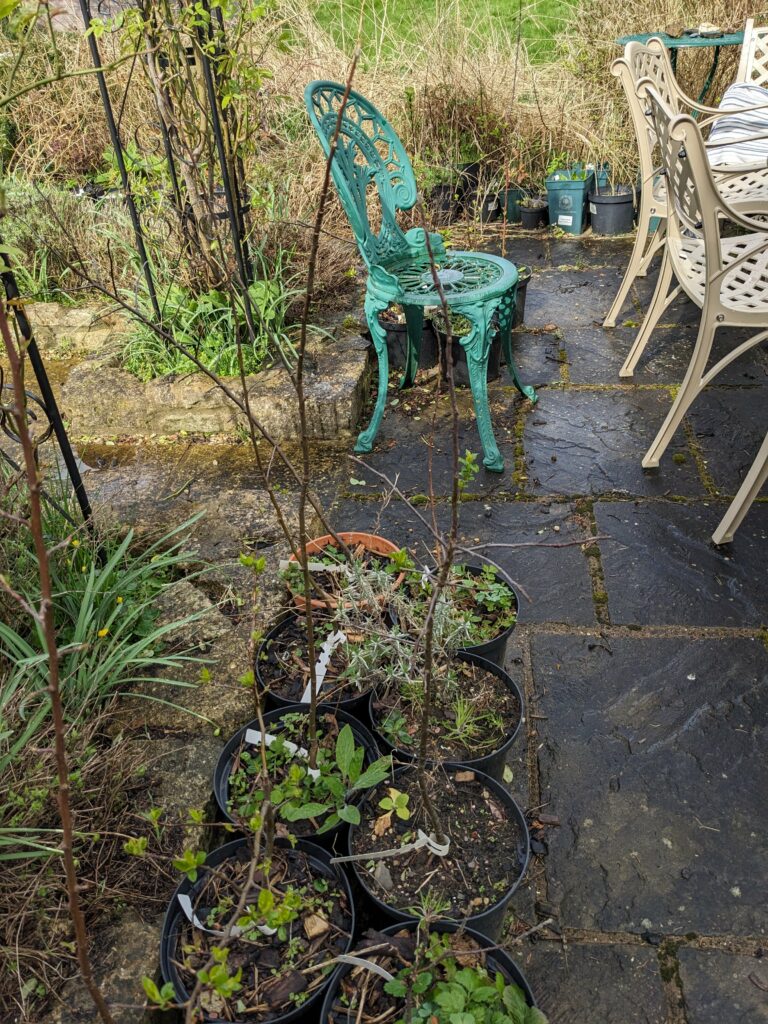
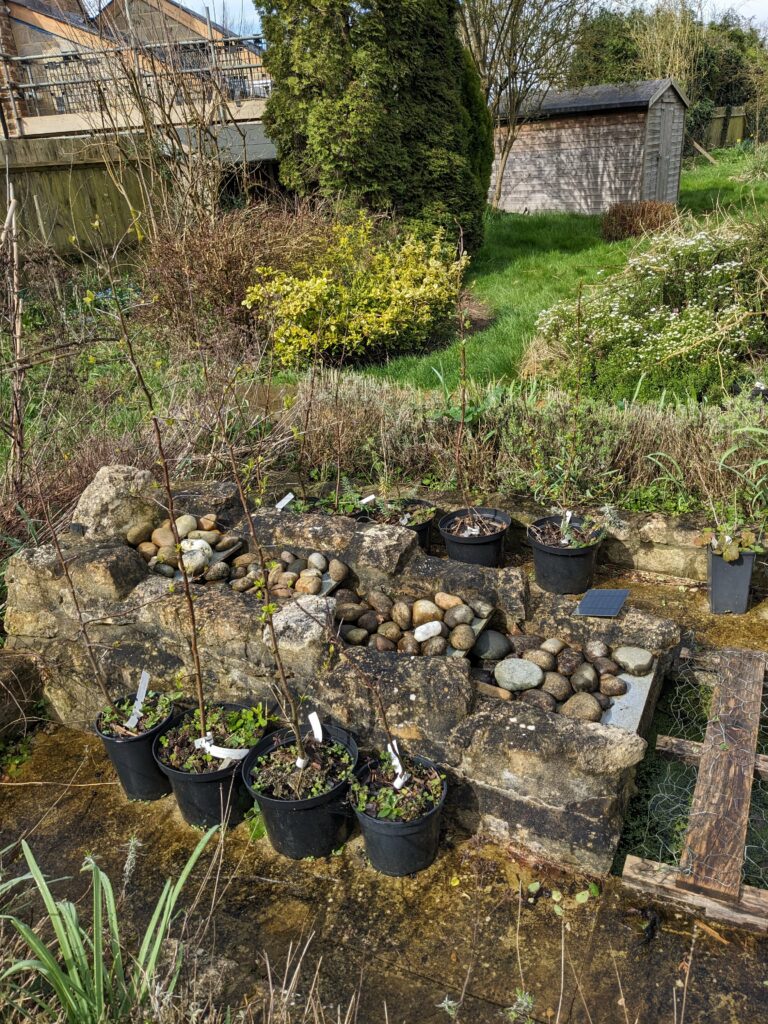
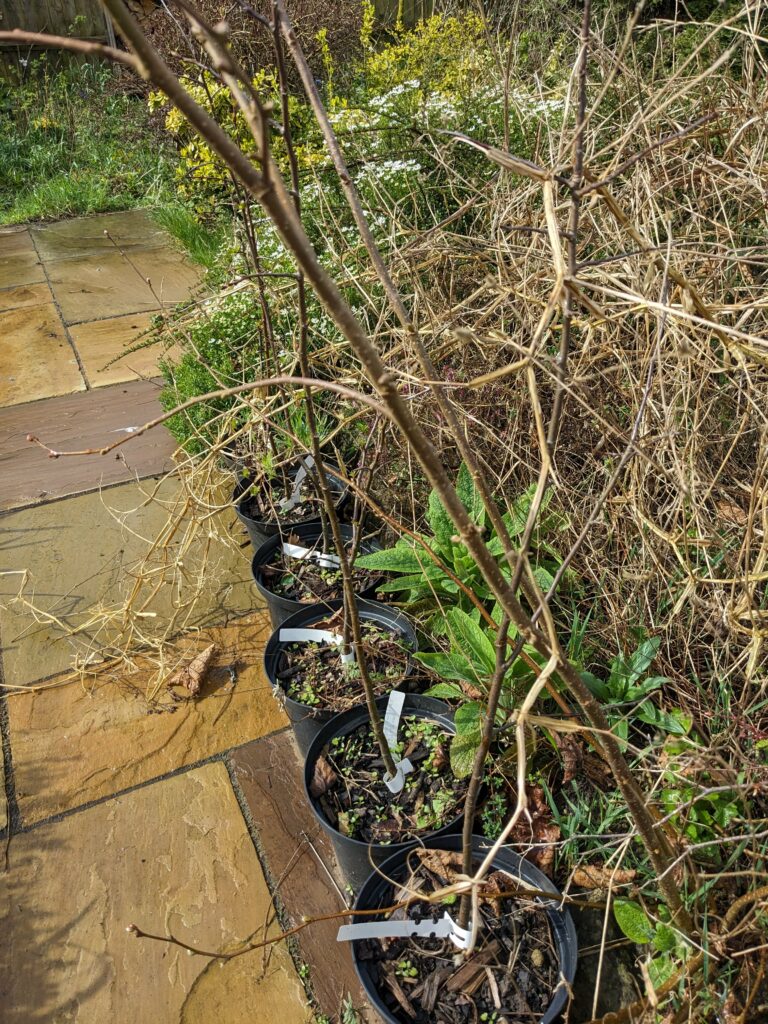
Despite the general distractions of life, I managed to gather a fair proportion of the medlars, which by November were falling from the tree. The medlar is the only new tree so far to give a good crop of fruit. Most of the fruit trees were planted in 2018, so they’re five years old, and generally look healthy, and flower well, but are giving between “some” and “no” fruit (YES “Fairleigh” damson tree I AM looking at you).
I put the medlars in the utility room and within a couple of weeks they had “bletted” and were ready to eat / use. Raw medlars are good with cheese, but I don’t regularly eat a cheese course after dinner, so wanted to find some other way to use them.
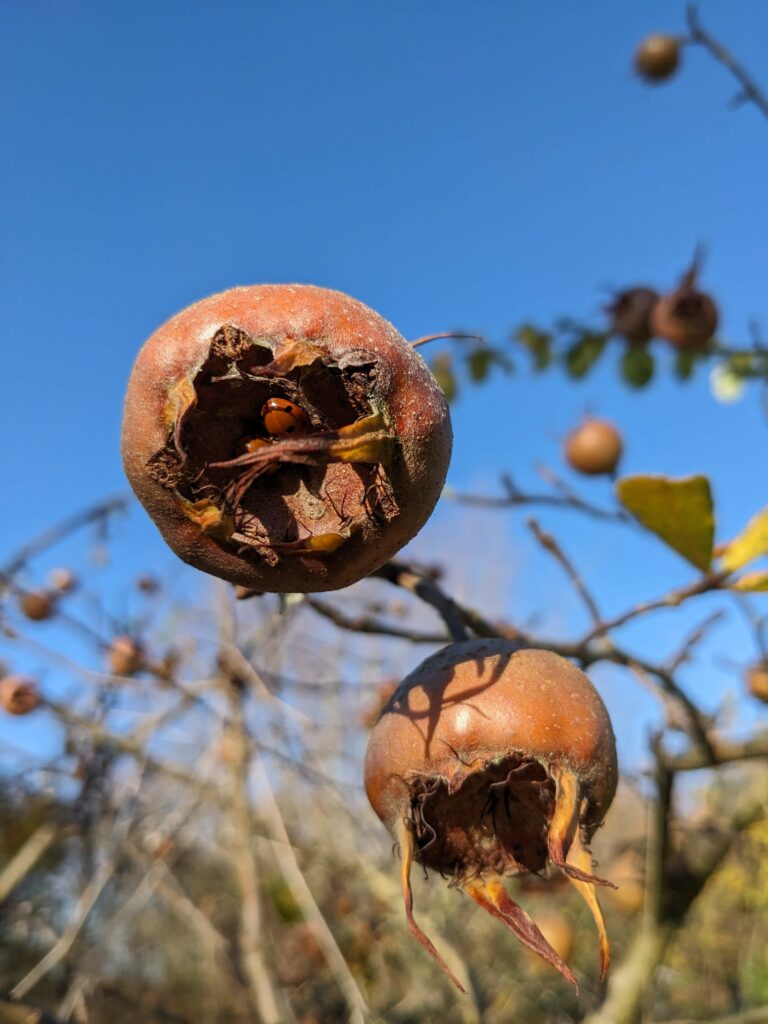
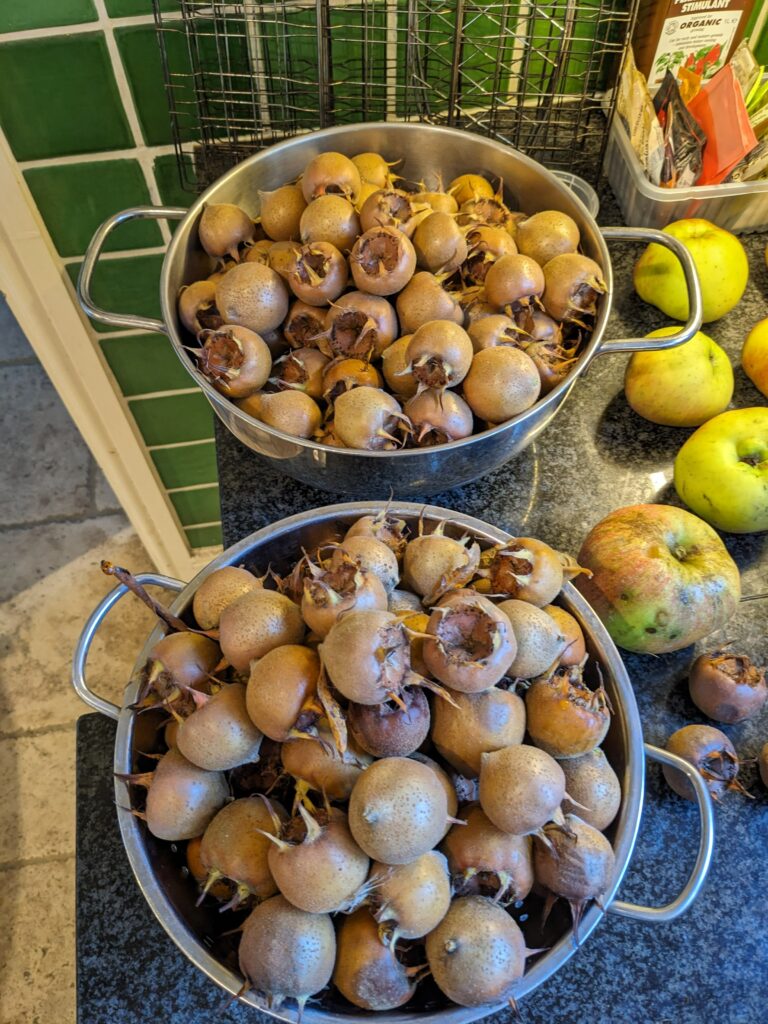
Medlars are tasty, but even once you’ve bletted them, they are not easy to eat; the pulp inside the “hip” is good, but there are plenty of seeds and fibrous bits. So this year, I tried boiling them medlars for syrup.
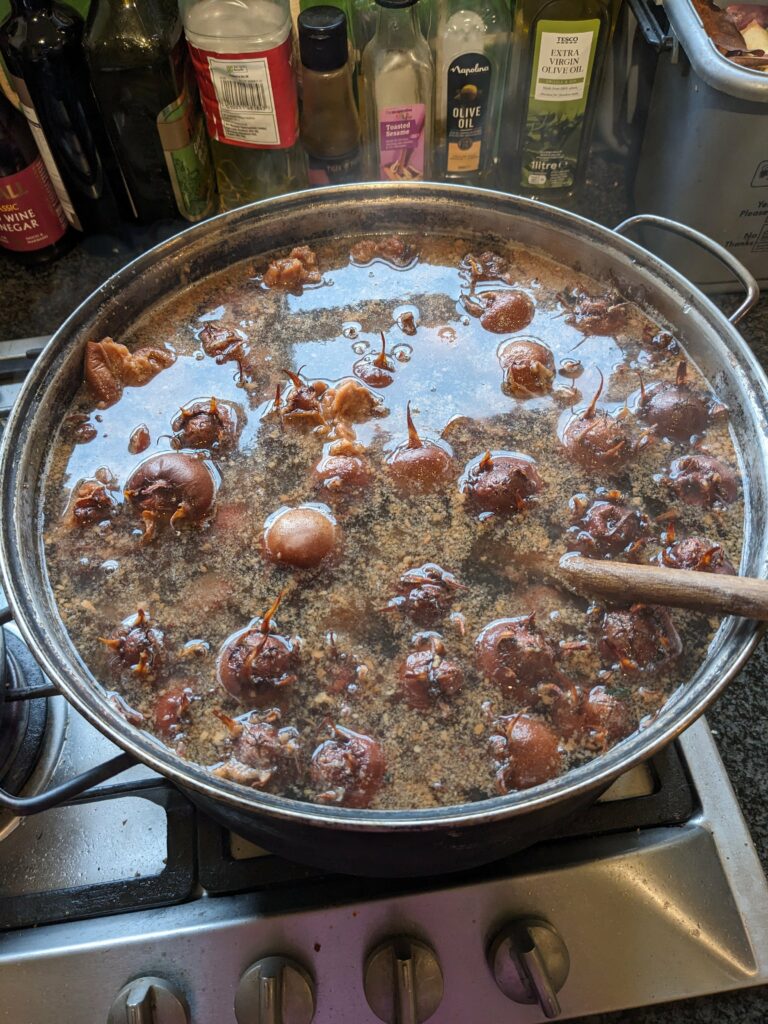
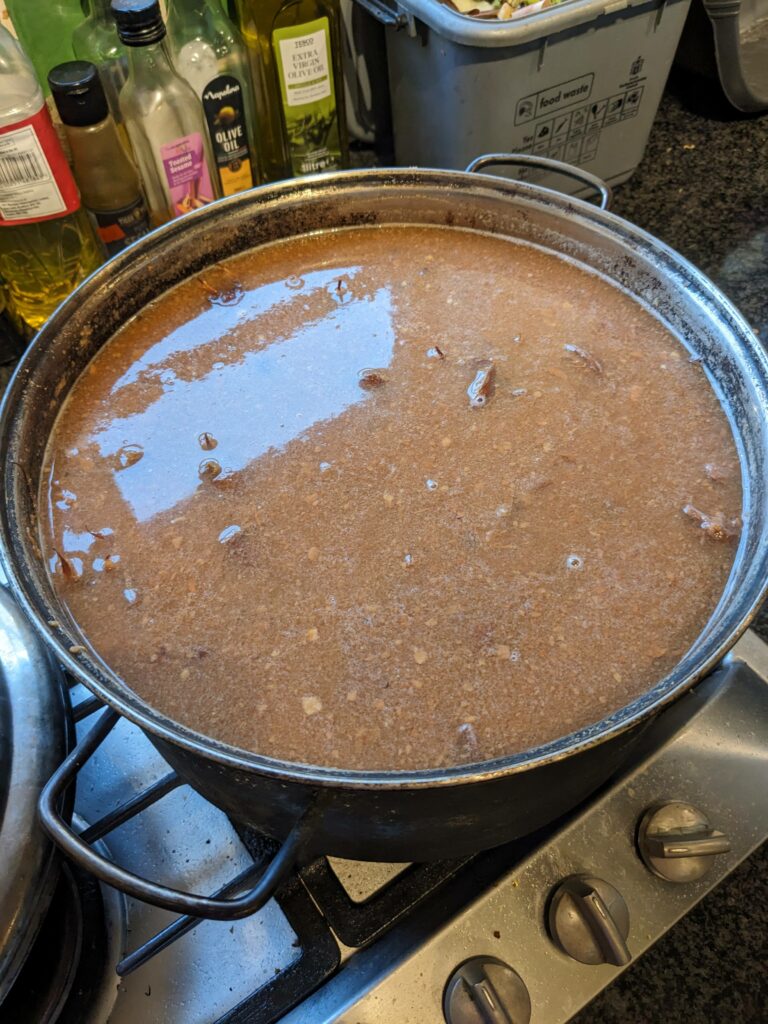
I strained the juice overnight through muslin. It’s a shame to waste so much of the fruit pulp, but I just did not have the time or energy to separate pulp from skin, seeds and fibre this year. The juice didn’t look particularly promising, but I froze a box of it to use later for a flavoured mead, and made the rest into jelly.
8 lbs medlars and 11 pints water yielded about 6 pints of juice.
I boiled the jelly for a good hour and a half before it finally reached a setting point. This was much longer than I expected, as the Certo is meant to reduce cooking time and improve set. On initial tasting, I thought there was too much lemon juice, but actually it’s fine. The jelly gradually turned a very pleasing clear orangy colour, and has a delicate flavour. It’s a bit stickier than would be ideal because of the long boiling – it’s on the verge of turning into caramel – another time, maybe more Certo? For traditional jellies like blackberry, I use unripe apples in August / September, which are chock full of pectin. As the medlars aren’t ready to use until December, the apples are far too ripe to provide pectin.
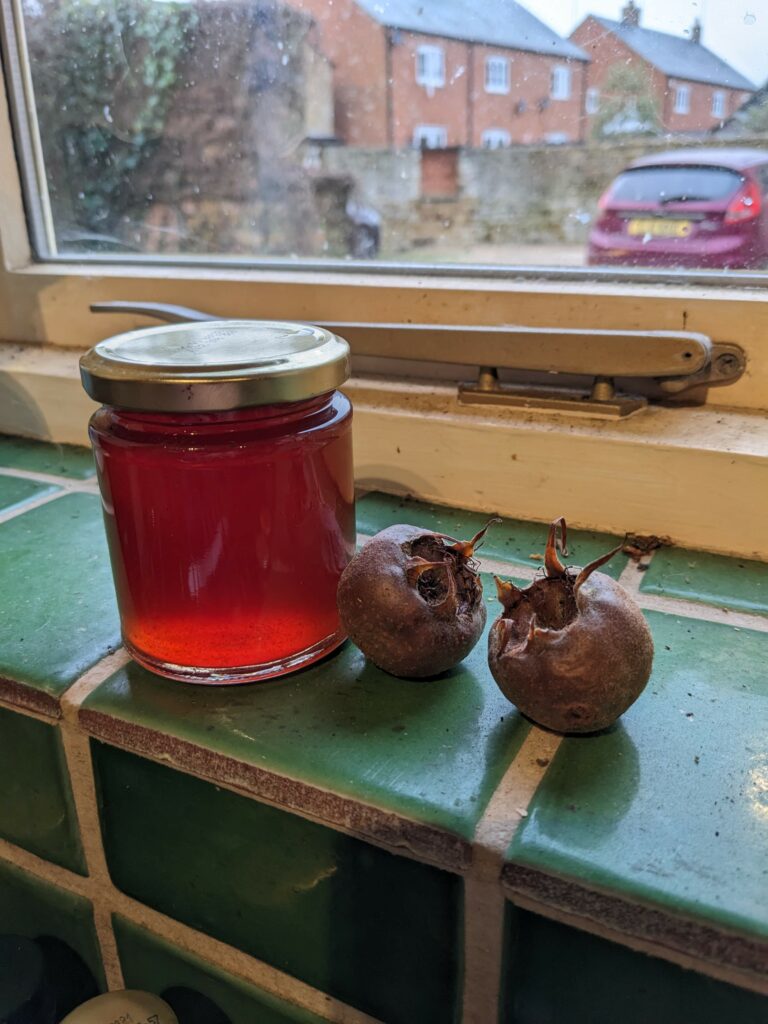
The rest of the juice is in the freezer and I plan to try making a mead with honey, medlar juice and apples. This will be a longer term project!
The heritage apple trees are still not producing much fruit and I’ve scoffed what there was. But the old Bramley in our garden has given us many fine apples. Last year, we stored a good number but the rats, not surprisingly, made a bee-line for them (surely you can’t have too many animals in a metaphor) and deprived us of several trays of good apples.
Al, being the hero that he is, has reinforced the apple store, which lives in one of the guard-rooms in the gatehouse, with wire mesh. This is of course not historically authentic! Vermin-proof food storage will have been a perennial problem, with grain stores raised on ‘mushrooms’, sealed pits and other strategies used with presumably varying degrees of success.
I almost filled the store with the best apples, as they should keep for longest. We still have a good number in the kitchen that need to be used up asap. Stewed apple for breakfast, crumble for supper…it’s a rough life.
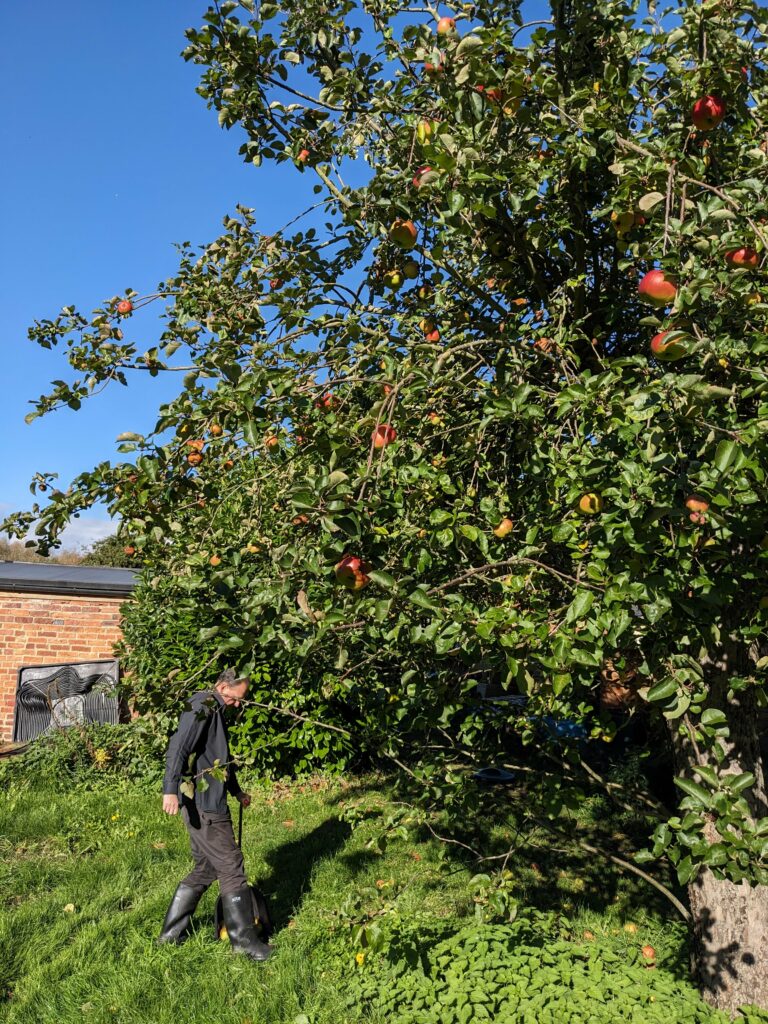
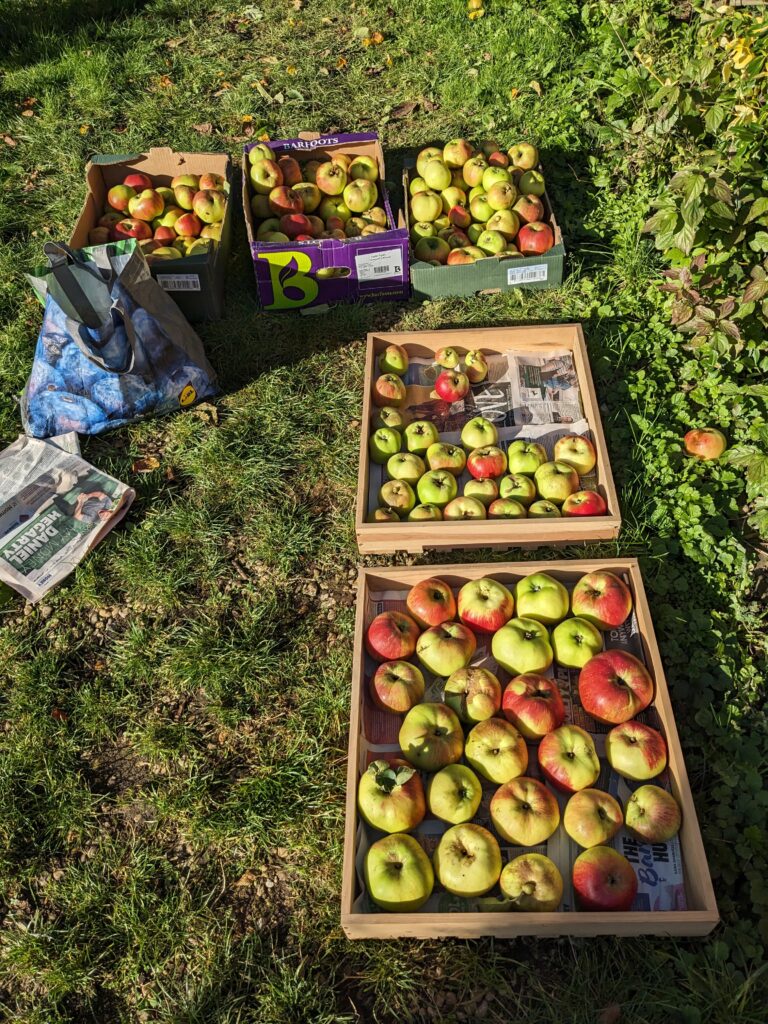
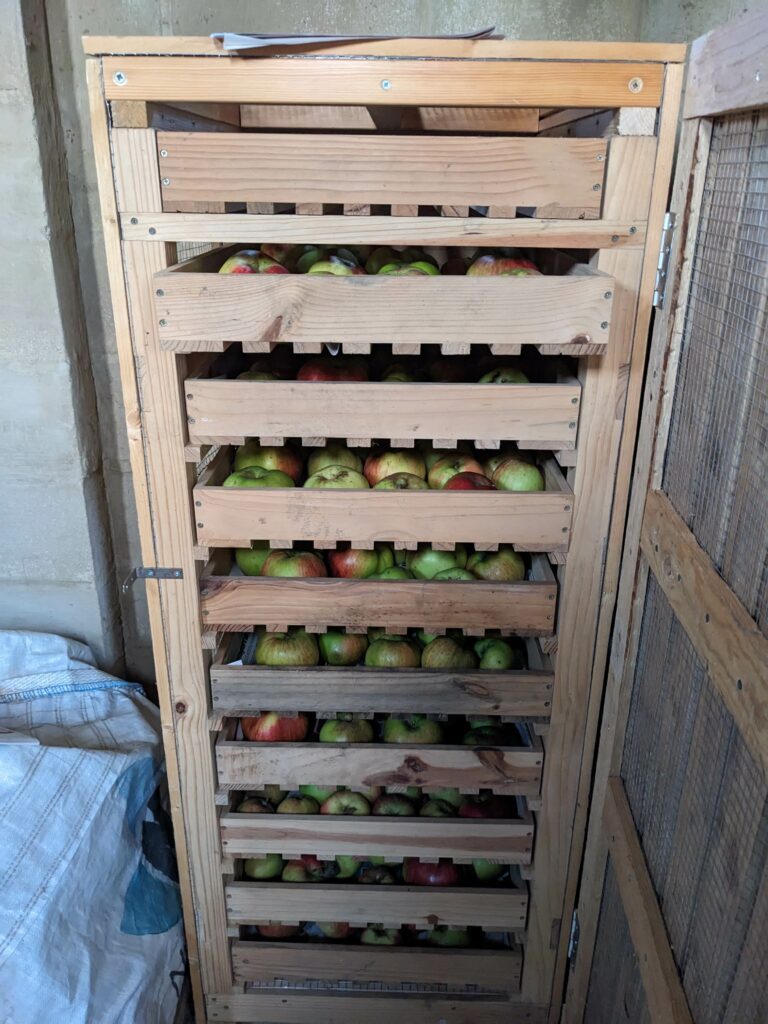
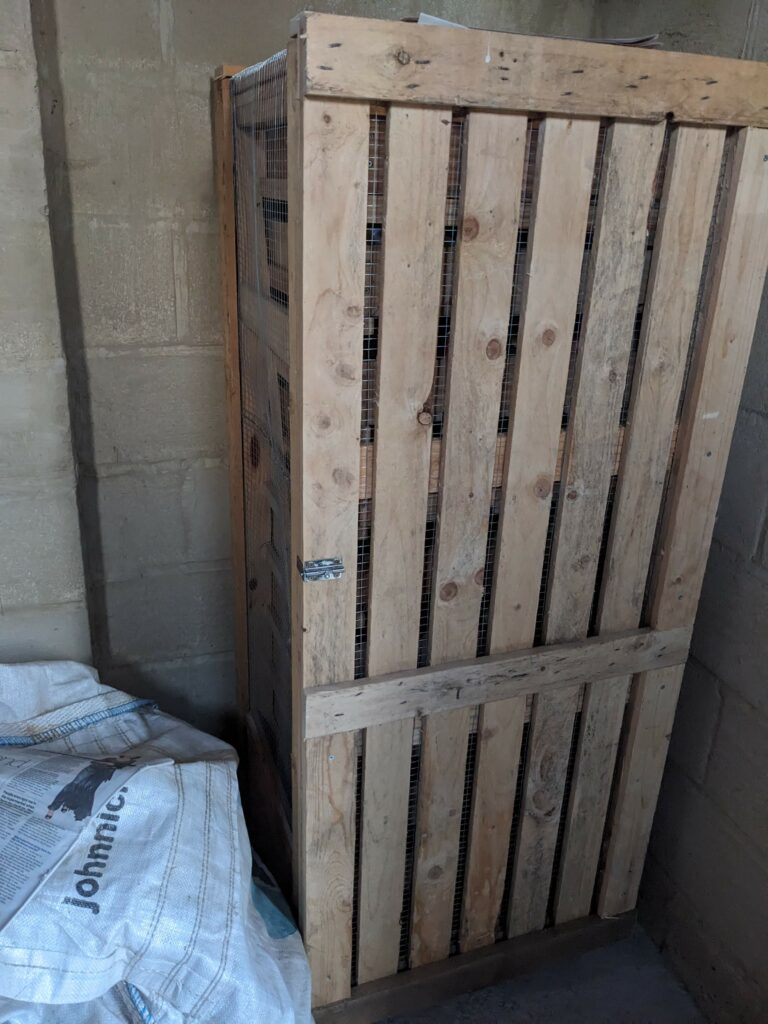
The orchard continues to be a mystery to me…the apple and pear trees planted in 2018 are still not producing significant fruit. This year the pears flowered profusely, there were no late frosts, but nevertheless, the fruit that set all fell and we have no pears. The Wyken Pippin has a few apples, and the Hambledon Deux Ans produced one solitary apple – but it was large, much larger than its few fruit last year.
Reluctant to pick it before it ripened, I left it on the tree; the Hambledon is supposed to be a great keeper. But the other day, it had vanished off the bough, and I found it on the ground – fortunately intact. I therefore cut it up and ate it. Some of the flesh was already discolouring, so it clearly wasn’t a great apple and wouldn’t have kept any longer. But the flesh that was ok tasted nice; it’s been described as a cooking apple, and I found it a bit sweeter than a Bramley but quite tart.
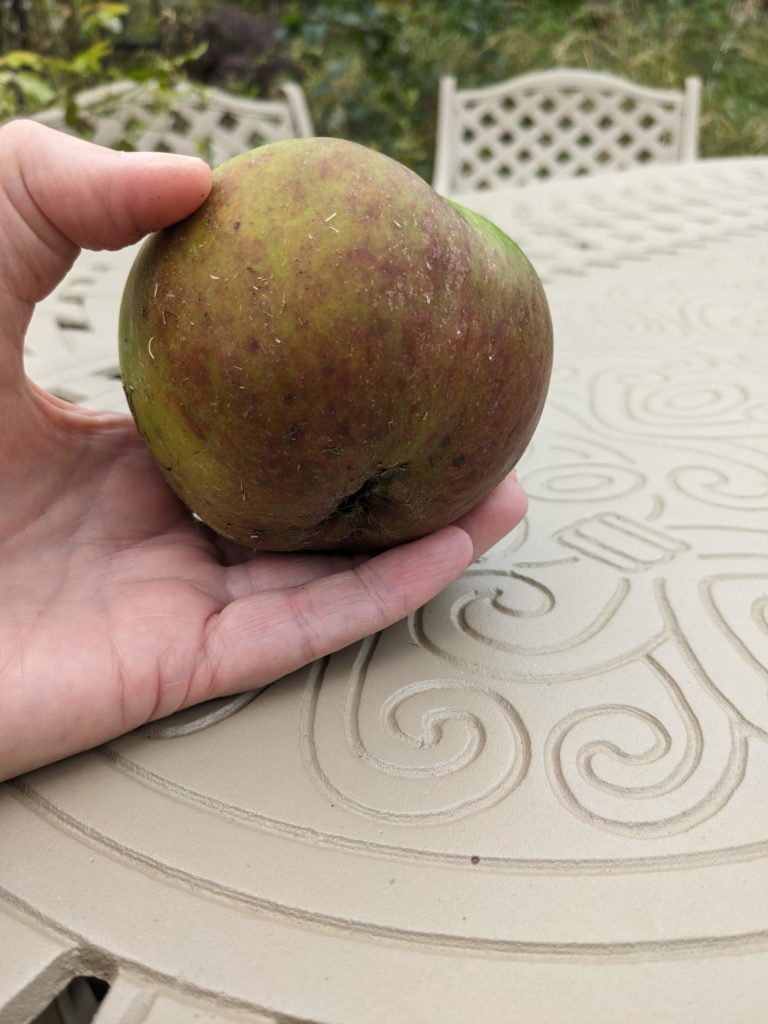
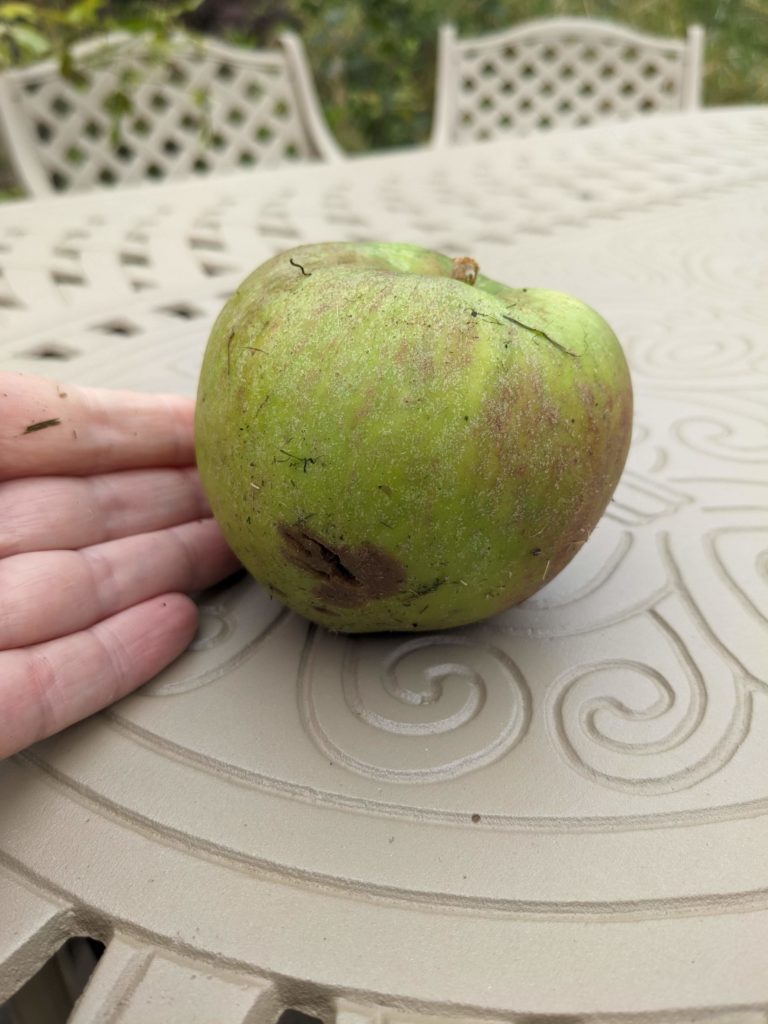
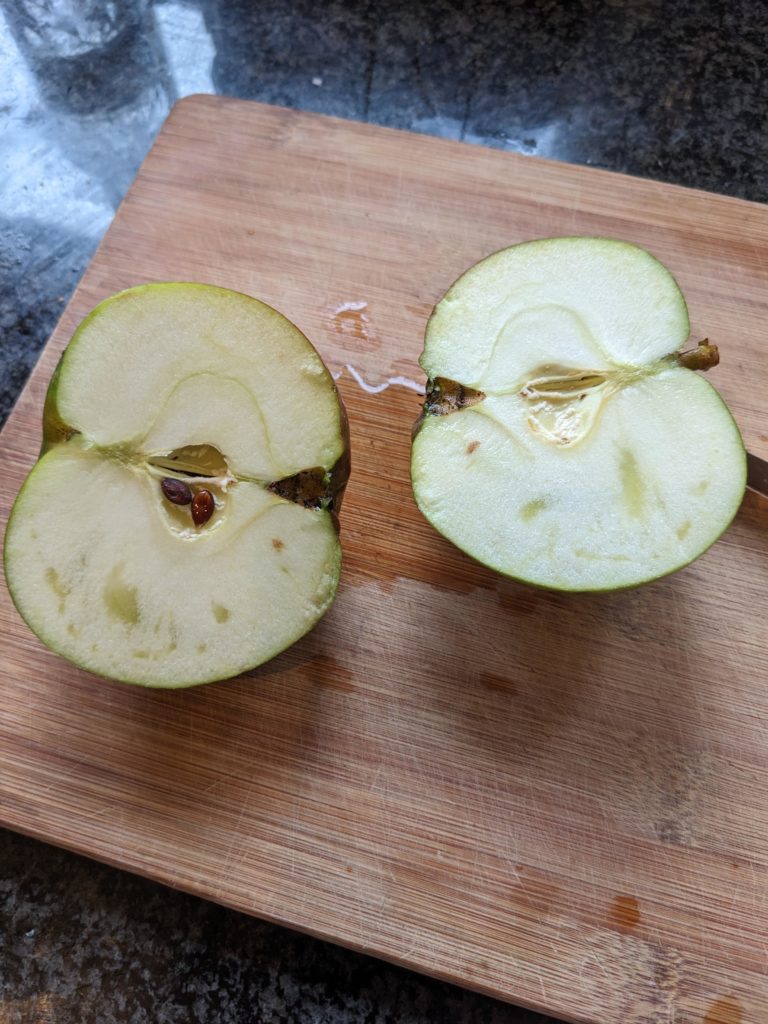
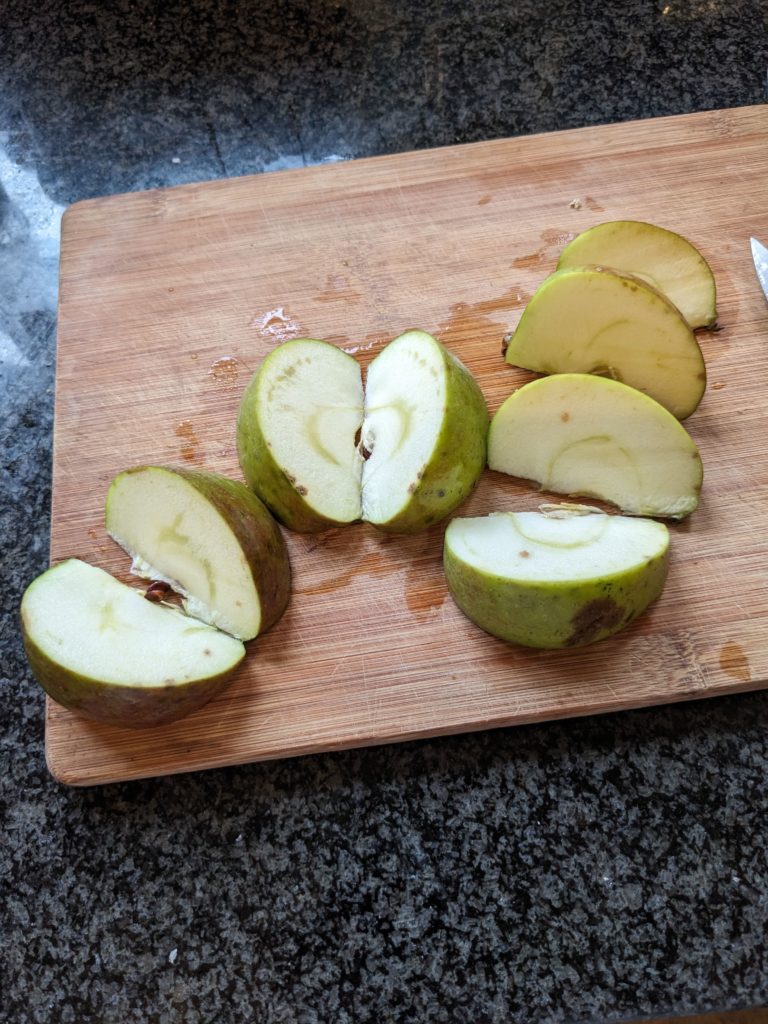
What’s up with the trees? I don’t know. The mature eating apple tree in the orchard (variety unknown) has some excellent fruit but many small and malformed fruit. Is this a disease? Is it too warm in the winter? It’s not been a drought year, nor has it flooded, so it’s a mystery to me. I keep hoping that *next* year, the new pears and apples will start to produce.
In the meantime, there are many medlars!
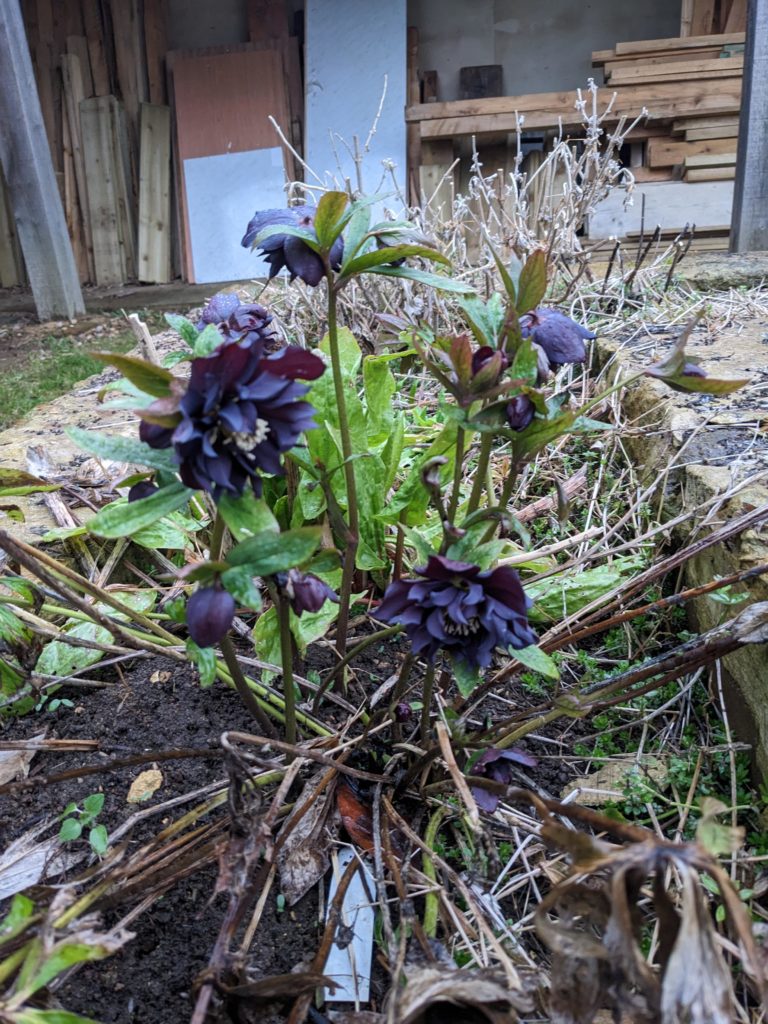
OMG it’s the end of the first quarter of 923, the equinox is past and here I am writing just after the Feast Day of that most learned and well-travelled princess Saint Hildelith, abbess of Barking. The black hellebore or “Christmas rose” is flowering in fine style. This is a plant of complex character, a winter flower bringing hope of spring, a medicine and a poison. I read that:
Treating intestinal worms lasted into the 18th century. The only drawback was that the patient might end up being killed together with the worms.
https://poisonousplants.ansci.cornell.edu/christmasrose/christmasrose.html
This comes as a surprise to me; I deliberately avoided planting what I knew to be toxic plants such as foxglove and aconite in the Rumwoldstow garden, but hellebore passed me by, partly because the hellebore is such a garden staple. So, erm, whoops! It is out of place in the food-and-flowers garden, and belongs in a medicinal garden with health warnings. It reinforces the message that you should be awfully cautious of eating random plants from the garden…
Moving swiftly on, here are some snaps of the light snowfall we had earlier in March, as viewed on a walk through Rumwoldstow to the end of the orchard and back.
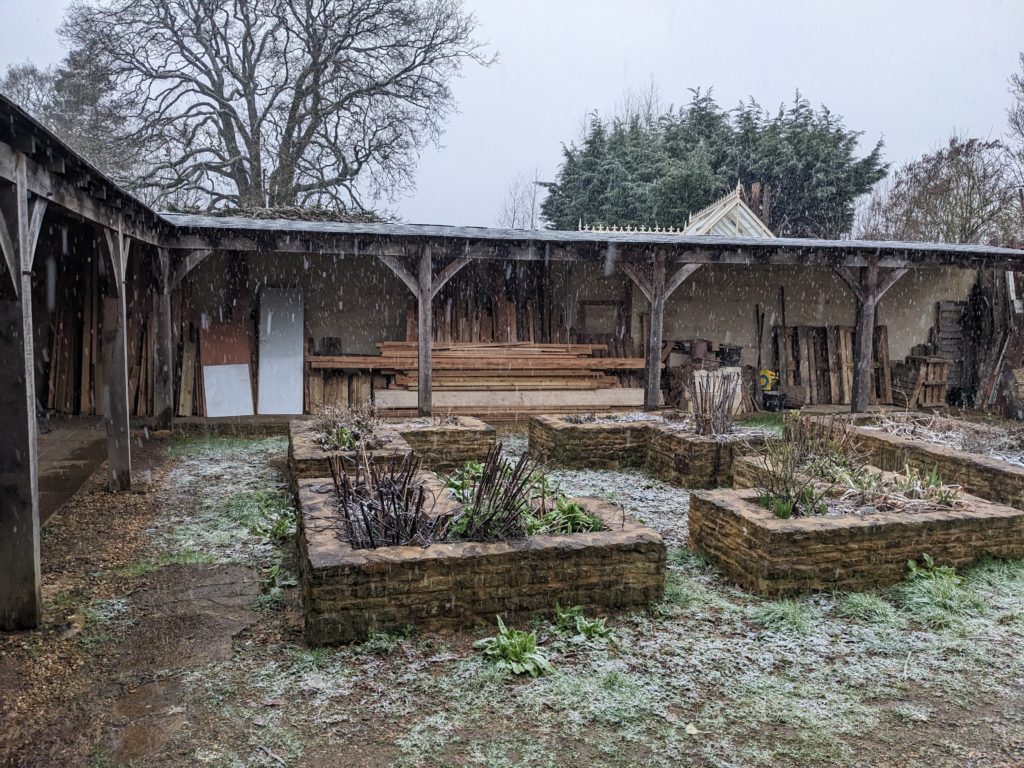
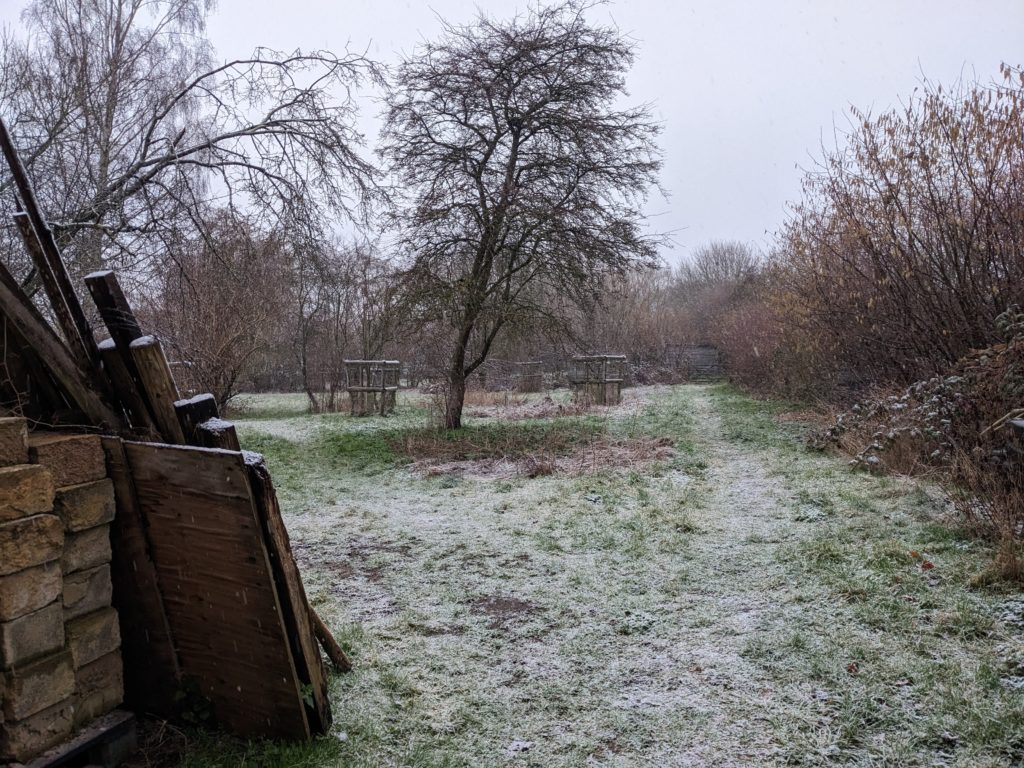

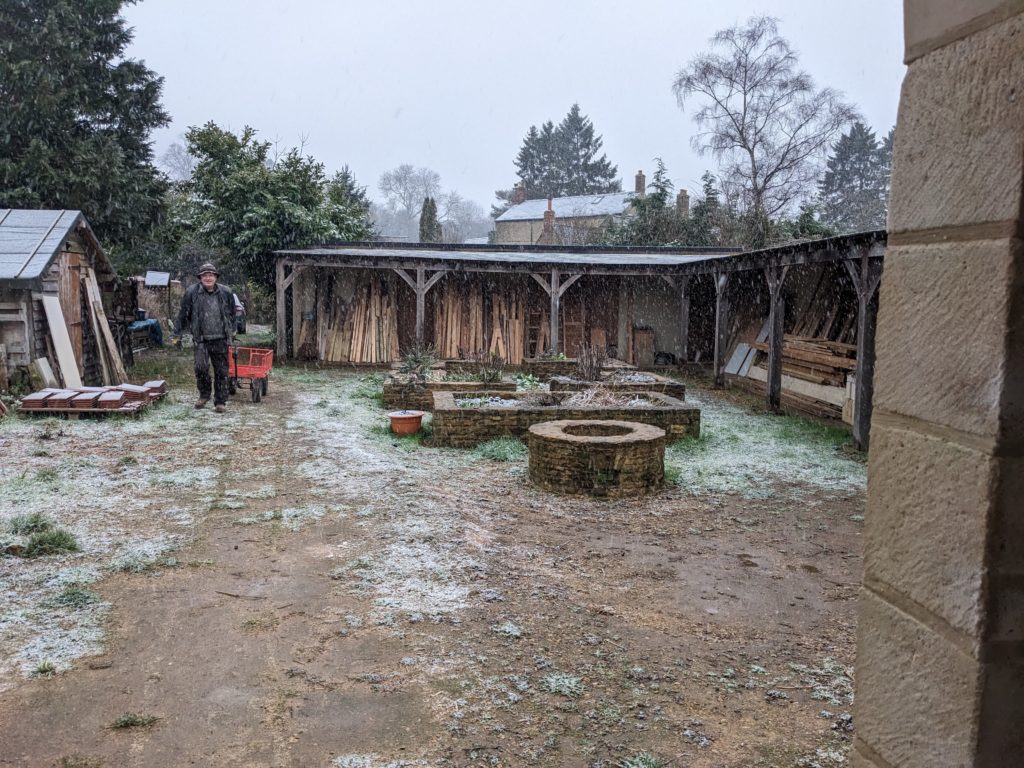
An orchard in February doesn’t look like much, but there are promises of spring appearing – snowdrops, catkins, and swelling buds on the trees. High time to prune those apple and pear trees!
Our first task was to prune the older tree, which we’ve been gradually reshaping to a proper ‘tree’ shape (it had grown very siiiiiiideways due to the light from the south being blocked). We went at it somewhat cautiously, pruning a bit at the ends, and removing branches that crossed each other, or went too much straight up.
The variety is unknown but it produces nice eating apples.
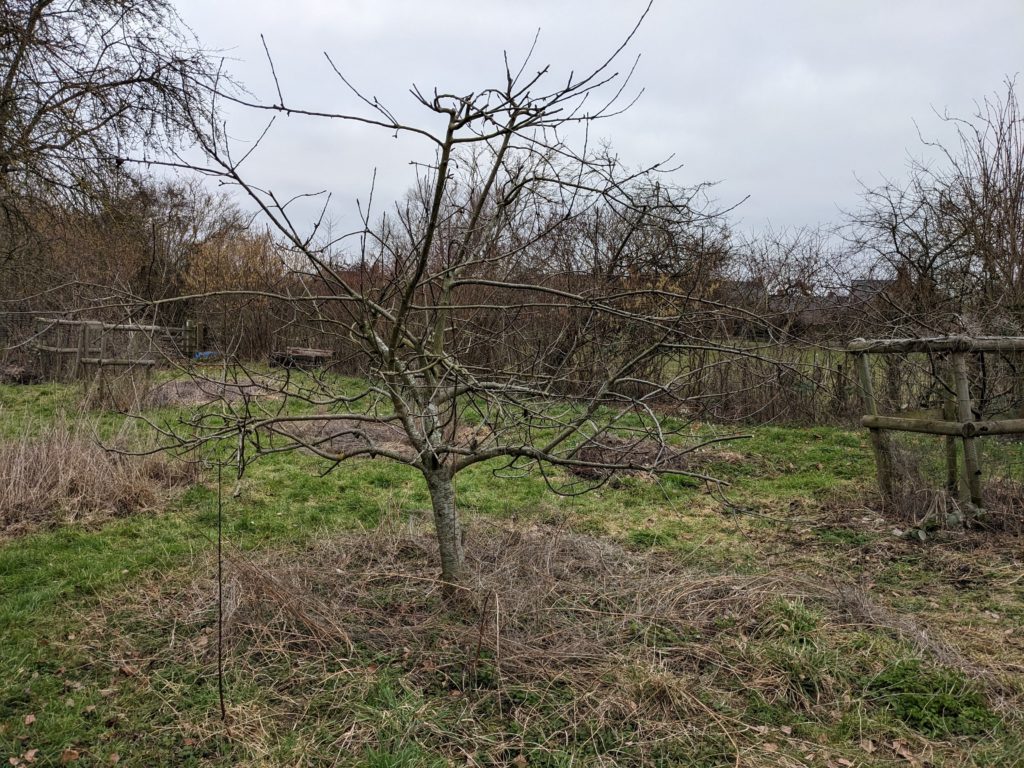
The Hambledon Deux Ans got a bit of a trim, as did the Wyken Pippin. This latter is such a sturdy tree now, and has kind of gone sideways, so Al removed the protective frame around it. We’ve kind of decided to keep livestock out of the orchard now, as it’s clear that the fruit will always be low enough to be munched even by sheep. And the frame was very rickety. But it may be reused later.
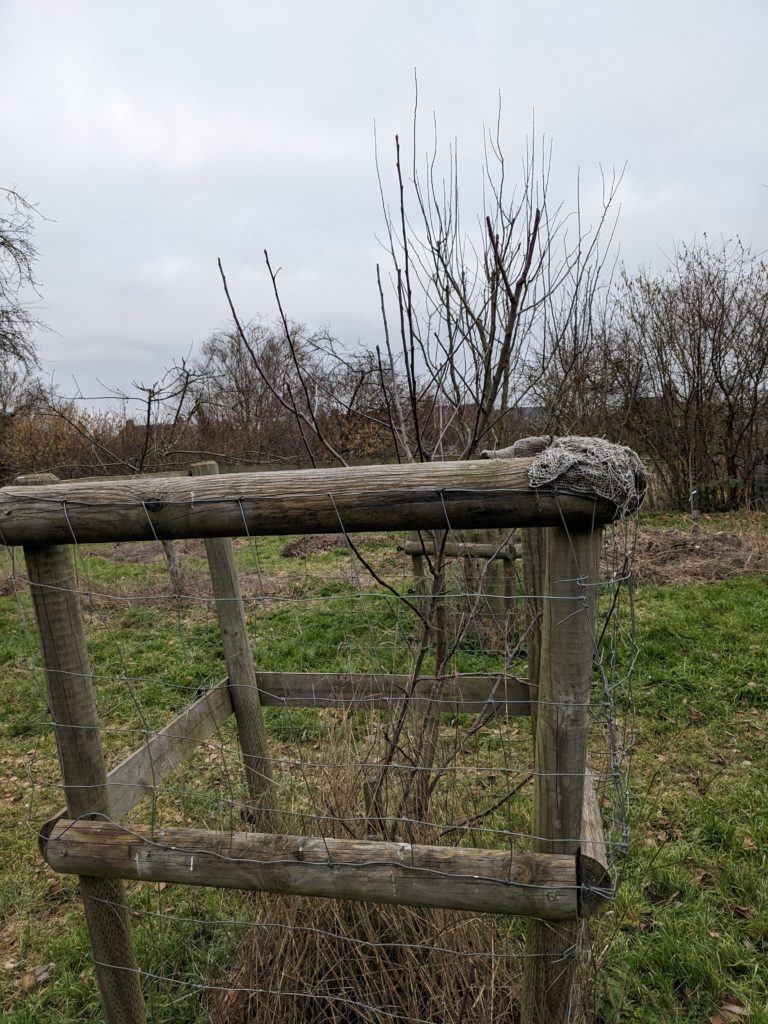
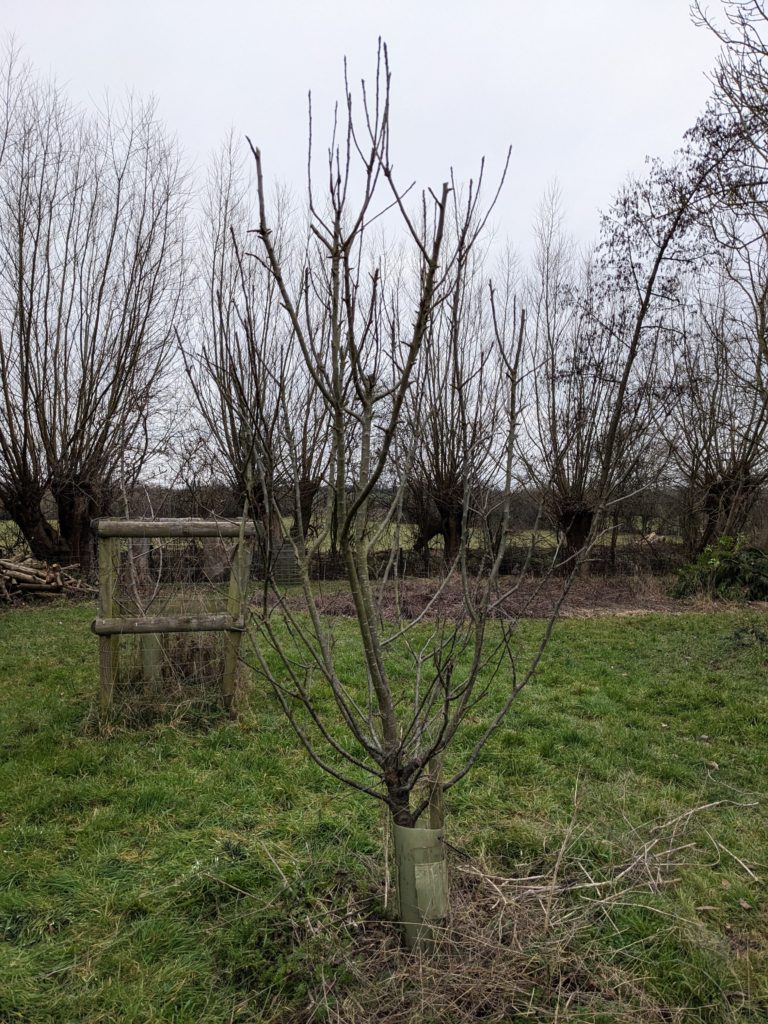
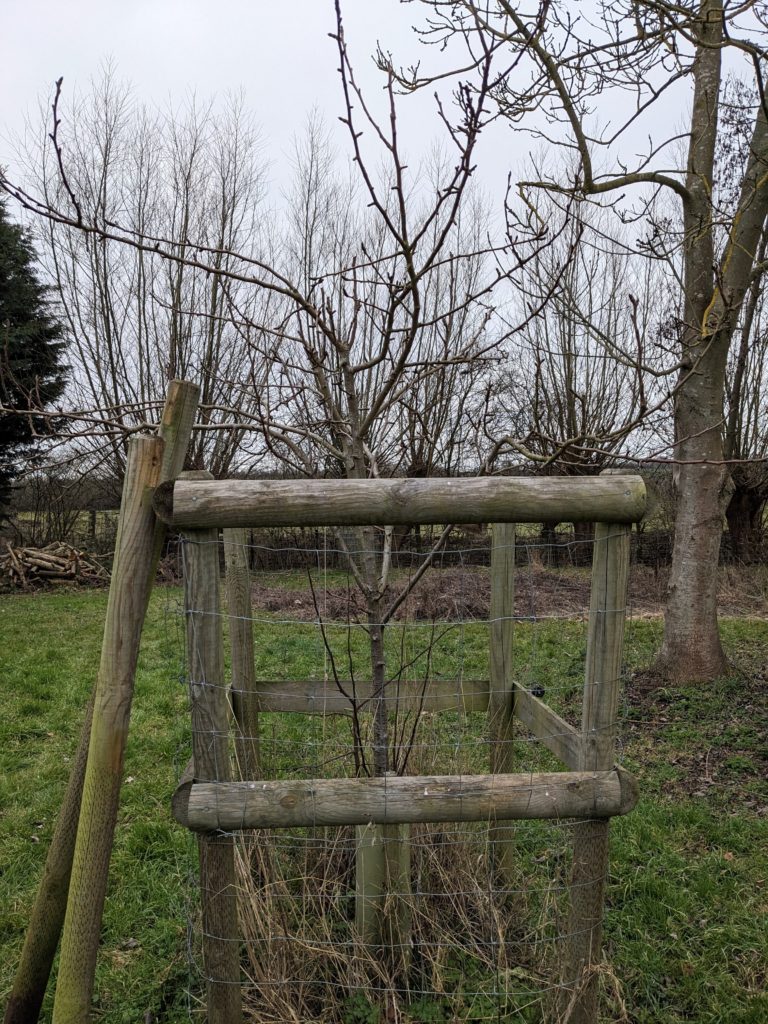
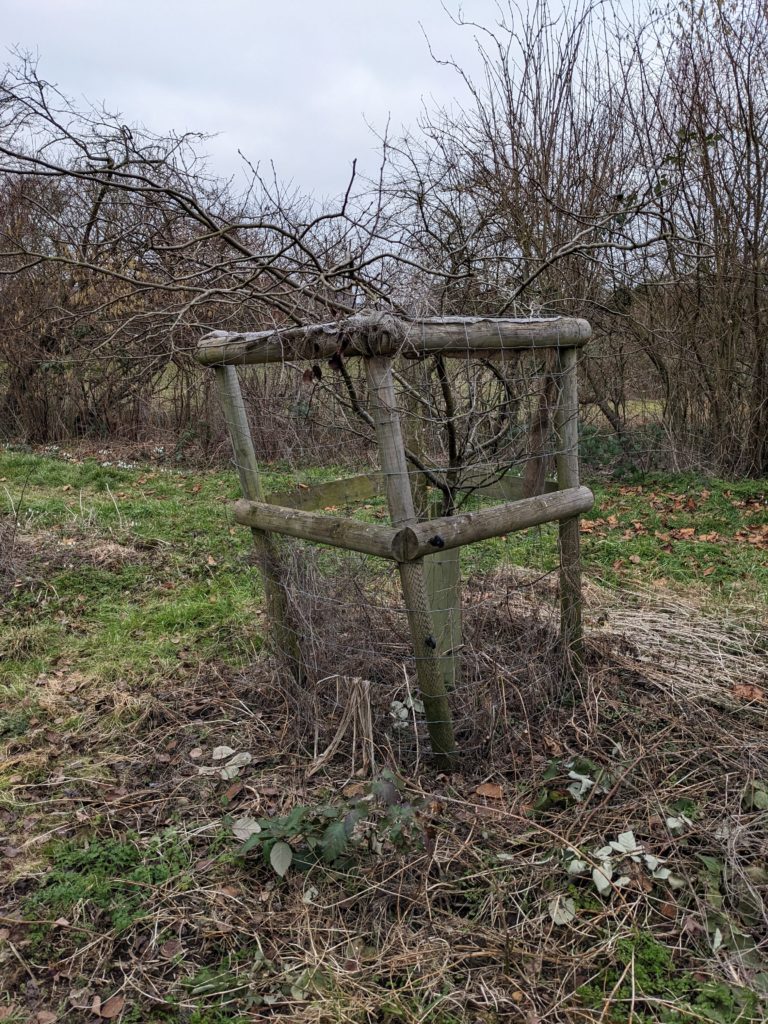
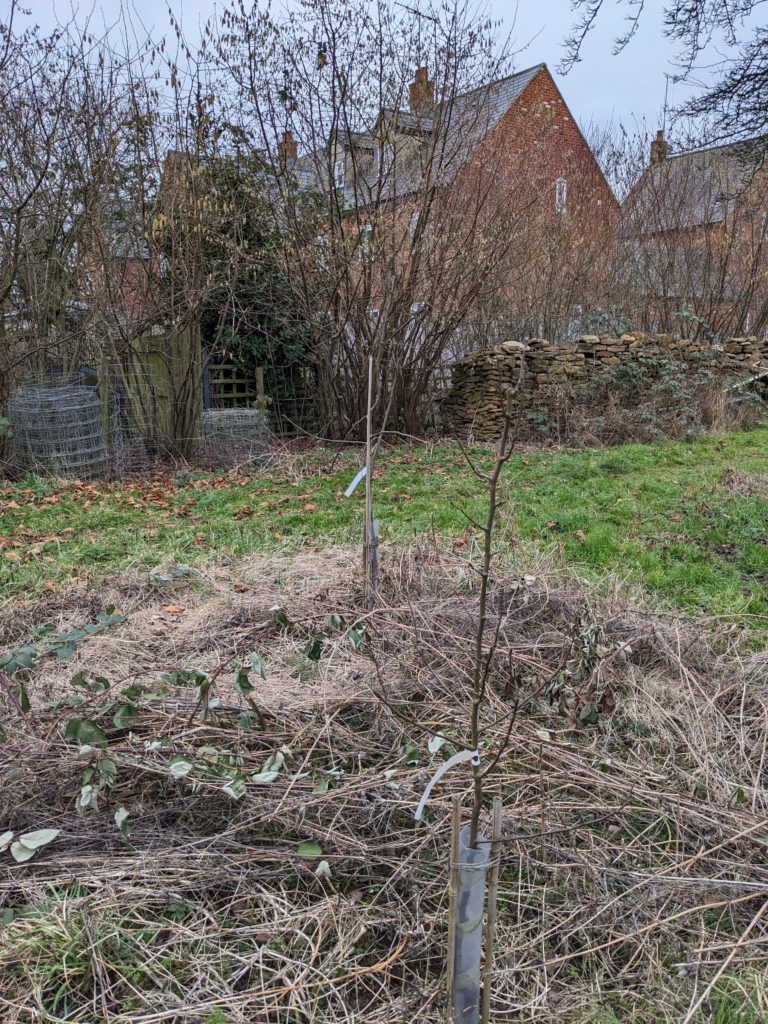
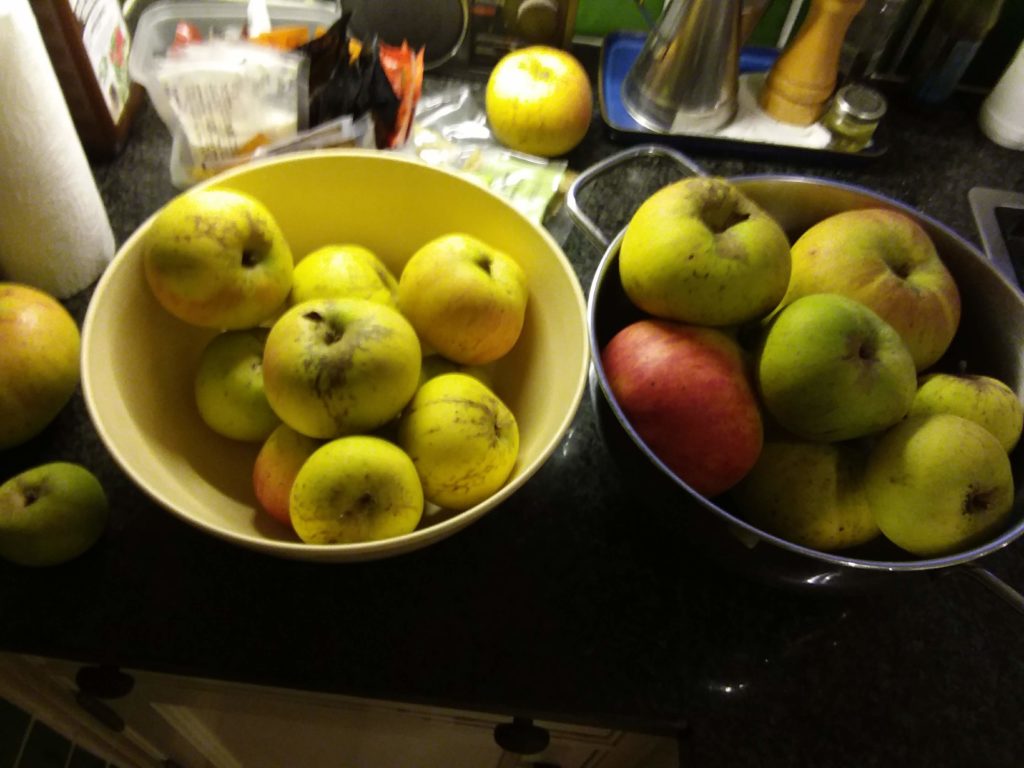
Candlemas has been and gone, marking the beginning of the end of winter, and the first signs of spring as the days lengthen. Indeed the name of the coming Christian period of fasting, Lent, derives from the Old English ‘lencten’ meaning ‘lengthen’.1 Although rats ate most of the good eating apples in the apple store – and this would be a disaster in a farming community, and we’ll have to rat-proof the store for next year – the Bramley apples proved less tempting and although there were some depredations, most were left for our use. Their keeping properties were mixed, with some surviving well and others decaying. By January they were mostly showing their age with brown fibres appearing in the flesh. On the 29th January 2023 we brought the remaining apples in to the kitchen.
Over the last week I’ve worked through them, and about one in three has eatable flesh now. If I’d been more organised I could have stewed and bottled or frozen vast amounts of good apple, but I just didn’t have the time and energy. I started eating the Bramley apples in August of 2022, as they were sharp but OK cooked, and they made excellent jelly then as they contain more pectin while unripe. So the tree has kept me in apples for about six months.
The trees now need pruning, and I have of course no idea what kind of harvest we will get this year, but I hope for a few more of the new apples, and that I’ll manage to look after the fruits better.
Last year for the first time we got a couple of apples from the young Hambledon Deux-ans apple tree, planted nearly five years ago now. It was the tree that was most munched by enthusiastic young cows in its first year and I’m honestly chuffed that it’s alive at all. I put the apples in the dining room and kept meaning to move them somewhere cooler but never got round to it, and finally decided to just eat them!
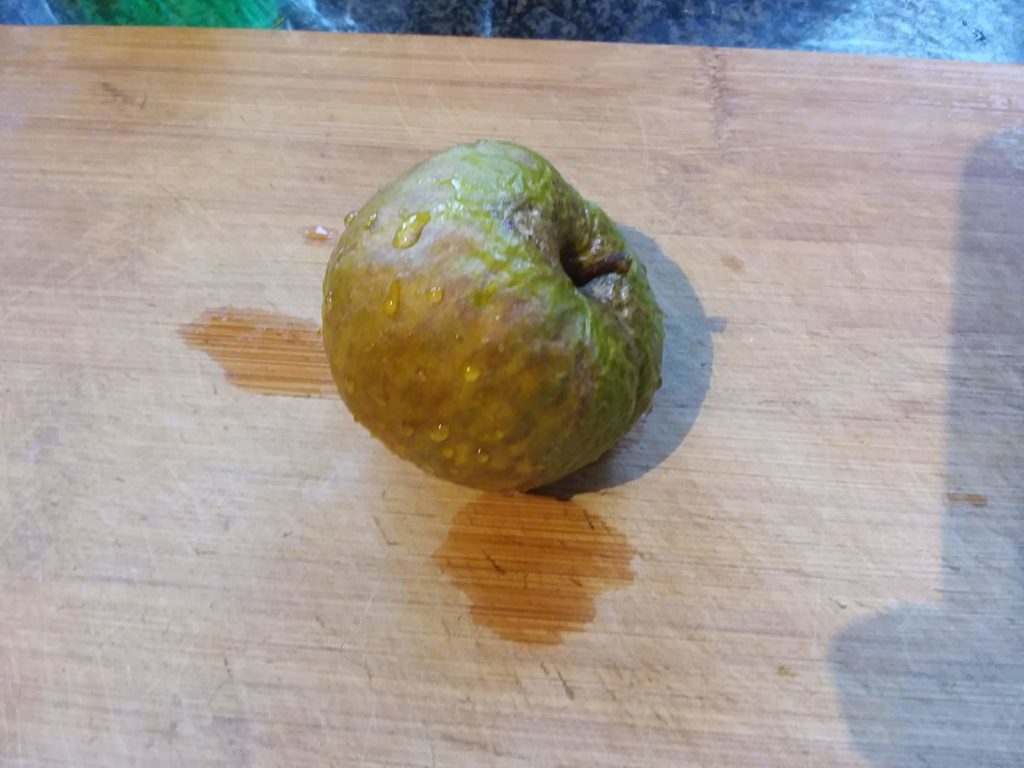
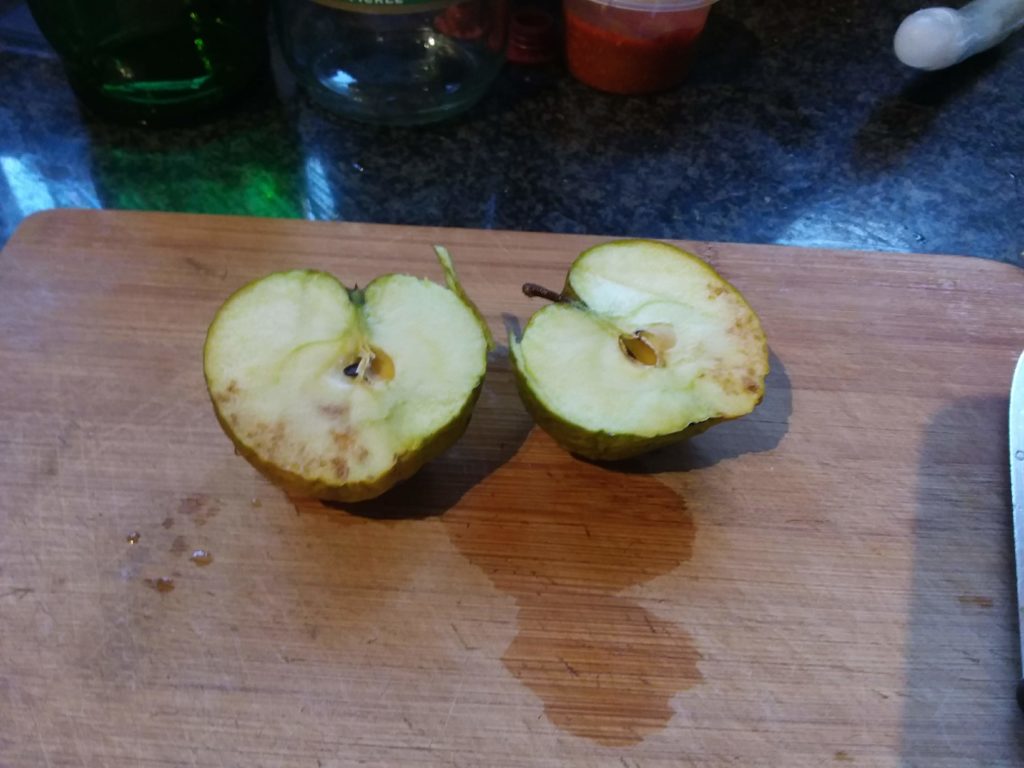
All things considered, I think the apple didn’t do too badly; more than half of it was eatable, though very tart. I can see why it’s described as a cooker. Fingers crossed the tree will do better this year, though with the hazards of drought and late frost, it’s an absolute unknown quantity.